TABLE TENNIS HISTORY

10 Times U.S. Champion


10 Times U.S. Champion
The first two issues had British world champions on the cover. Now we go with an American who seemed destined to win that singles title but fell short, even while he dominated U.S. competition for many years. In “Dick Miles, Professional,” we explore the many ways this self-described non-worker was able to make his lifelong living from table tennis. We also examine a fascinating never-before-seen letter Miles wrote when he was 24.
Can you improve your game by analyzing photos of history’s top players? We show you exactly how in “Play Like a Champion.” This revolutionary approach will have you questioning everything you thought you knew.
Readers continue to enjoy our series “100 Issues: Updates, Expansions, Corrections,” examining the 30 years of TableTennisCollector/TableTennisHistory Journal , 1993-2023. Part Three brings us halfway through.
Many international flavors are on offer in this issue, as always. We hear from a colleague in Italy about his new history book. Friends in New Zealand and the U.S. reminisce about favorite table tennis memories. Our history expert from Germany again provides important mid-century photos. From England, a past editor of TT Collector shares highlights of his collecting life. And we learn about a praiseworthy table tennis museum in Colombia.
All that and more!
Article contributions, ideas and comments are welcome Please direct new readers to the link below for all three issues ---
https://pingpongfeverautho.wixsite.com/table-tennishistory
Grant

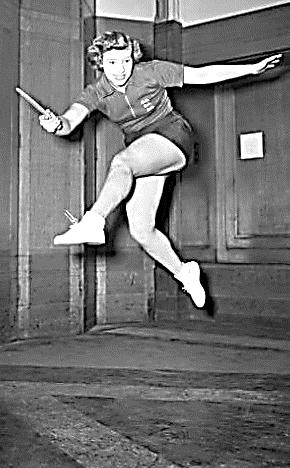

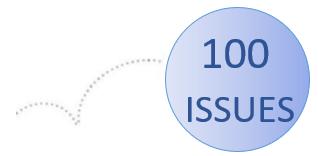

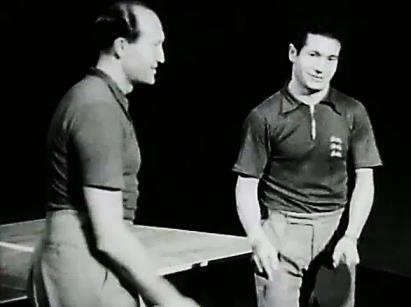
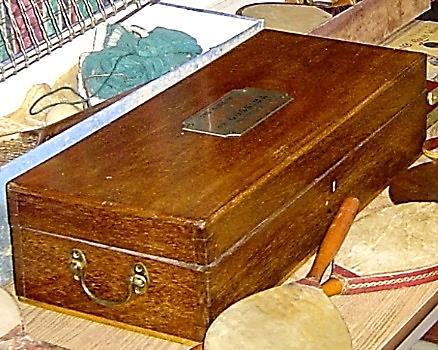




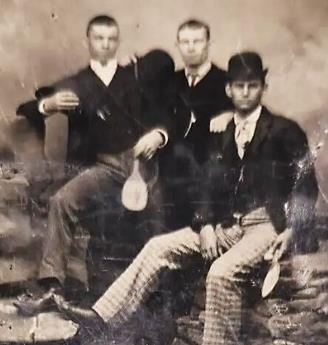
Very strict rules are in force to prevent anything savouring of professionalism, and players are not allowed to receive any hotel expenses or train fares without special consent. English officials, March 1928, as quoted by London reporter.
If table tennis has given pleasure to exhibition players (and it has), it seems they should be more than glad to give their time for the fun and glory. Table Tennis Topics magazine (USA), May 1935.
Players viewed it differently. They need to put food on the table. Moreover, they said, the national organizations should be pleased that top players are promoting the sport.
Fortunately, the governing bodies in the U.S., England and elsewhere finally consented to require only that the players register their intentions and/or get permission for specific events.
Dick Miles was the top professional in the U.S. and one of very few of his era to make an entire career out of table tennis. Exhibitions were a major part, but he also imported equipment, had his own Miles-branded equipment line, wrote books and many articles, did TV commentary and served as club pro at resorts. Oh, and he pocketed many winning table tennis bets.
Miles enjoyed a 25-year career giving shows for the USO (United Service Organizations), which paid talent to perform for active-duty military service members. The future ten-time U.S. singles champion was only 17 when he went on his first USO tour in 1942, partnered by U.S. champion Lou Pagliaro, his New York City mentor. This photo was taken about three years later at one of their shows, as they keep multiple balls in play. They autographed it for The Three Tops skaters, pictured below.

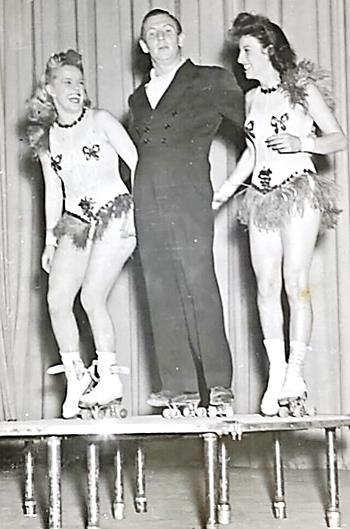
1953 example of one of Dick’s many USO tours
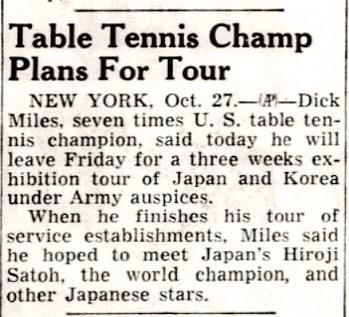
1963 USO appearance, as described in this navy base newsletter, Adak Island, Alaska.

In 1954-55, Miles traveled with the famed Harlem Globetrotters basketball team, doing shows at halftime with former world champion Richard Bergmann of England. They claimed to be seen by 1.5 million spectators in all. In March 1955, they took a break for the U.S. Open, where Miles beat Bergmann 3-1 in the singles final (right). This was Miles’ only Globetrotters season, whereas Bergmann stayed with them for the rest of his life 15 years.
The first of the two shows there had to be cancelled when bad weather kept their plane from landing. Winter Alaska was not a cushy gig! More comfortable perhaps were Miles’ USO tours in the Mediterranean later that year. He was then traveling about 40,000 miles a year.
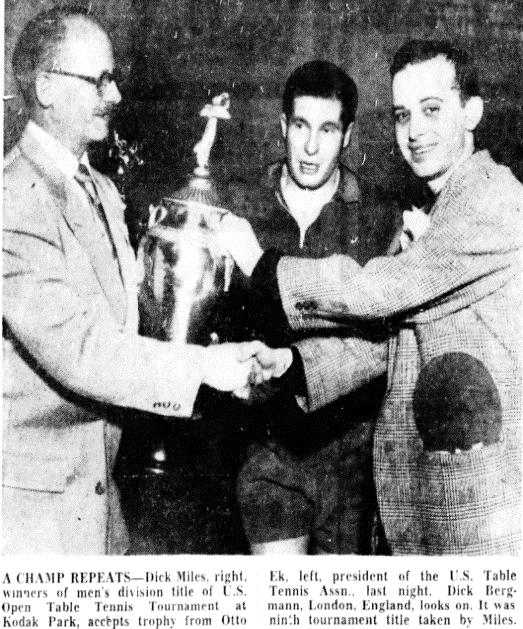
Miles gave many other exhibitions throughout his career. By the way, when he was 17, he actually had a “real” job, too, at the New York City Daily Mirror in 1943
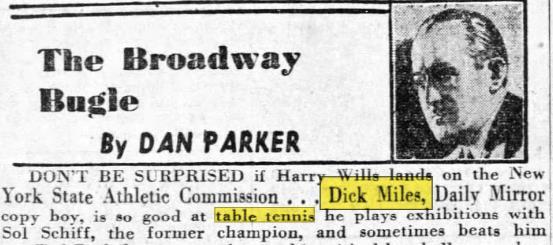



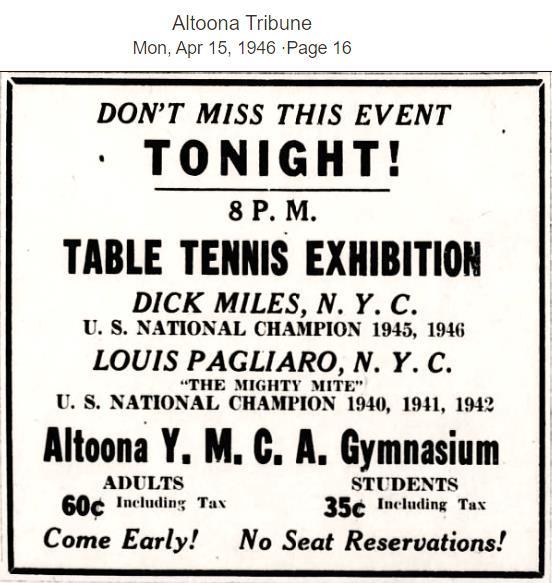
Miles and his fellow U.S. team members gave winter exhibitions in the UK in 1947, 1948 and 1949, since they were in that part of the world anyway for the World Championships and English Open. Here is the Belfast Telegraph, January 1, 1947

But Miles was impatient for a bigger payday.
Newsweek, January 19, 1948


Becoming world champ would boost his value
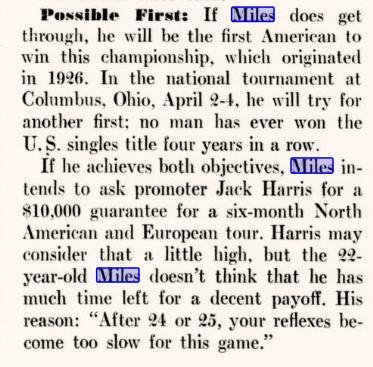
Miles did indeed win a 1948 world championship. True, it was in mixed doubles with Thelma Thall (left), not singles, but now he could be billed as a world champion. He also won his fourth straight U.S. singles championship.
And Miles did get his tour, partnered with none other than Richard Bergmann. No guaranteed payout, but Miles thought he and Bergmann could net a shared $20,000 (about $260,000 in today’s money). A Detroit suburb was one of the first stops. Their grand entrance into the high school gym is described in the October 1948 USTTA magazine
The drum and bugle corps made a complete circle around the playing area before Bergmann and Miles put in their appearance...perched atop a Detroiter table specially designed with wheels for the occasion by Detroit Wood Products. Locomotion of the table was obtained by a bevy of local beauties harnessed to a silken rope...As they passed the speaker’s stand with the Stars and Stripes on one side and the Union Jack on the other the applause was tumultuous; the very foundations shook as if an earthquake had struck...
Unfortunately, most of the tour was cancelled when Bergmann was called home to England for a family emergency. Or so the story went.
Sometimes Miles and others styled themselves “pros,” as in this New York event later that year
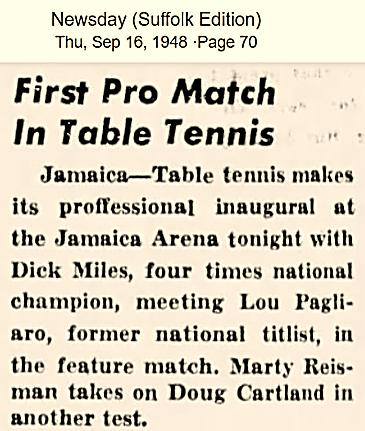
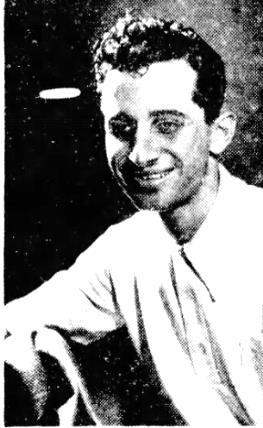
In 1972, age 47, his tournament days were behind him, but Miles was still doing exhibitions
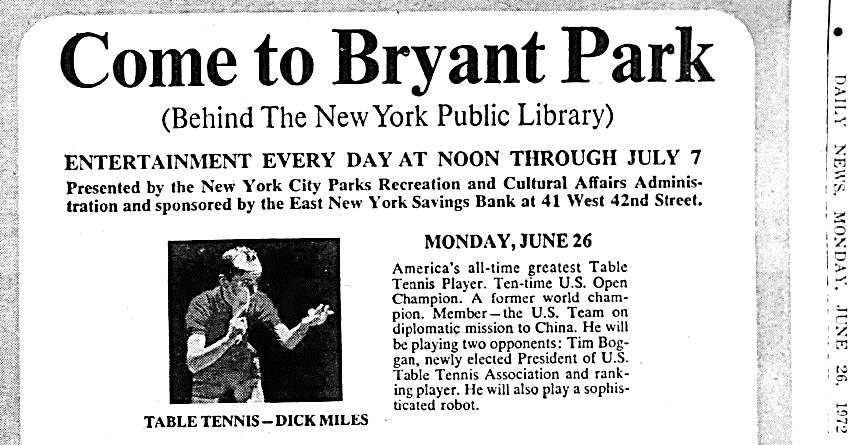
Miles was club pro at upstate New York resorts for a couple of summers. Grossinger’s in the Catskills in 1953 was one. That was also the year of a table tennis match there between famous boxers
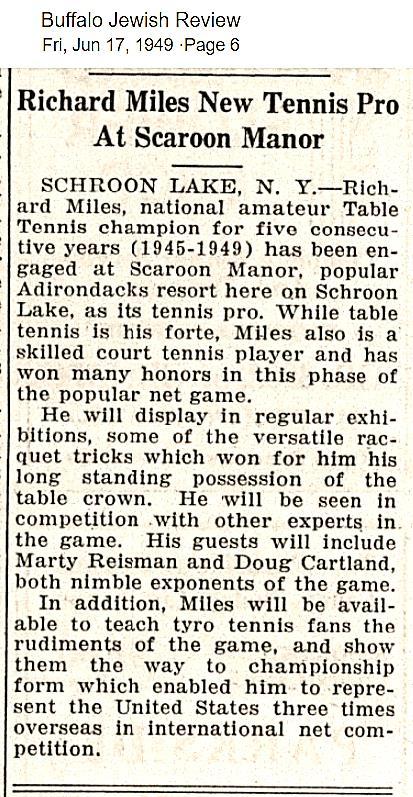
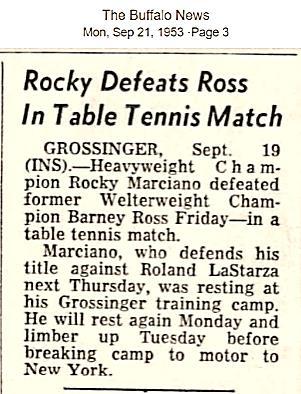
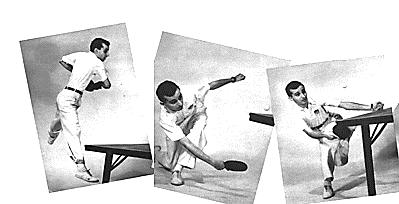
Farther upstate, in the Adirondacks in 1949, he was the racquet sports expert at Scaroon Manor (left).
Miles’ 1968 book sold well.
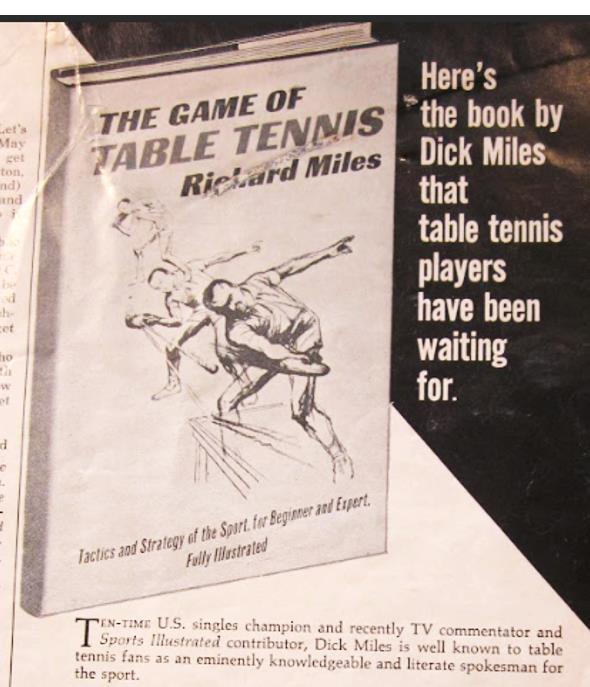
In 1974 Sports Illustrated published this book
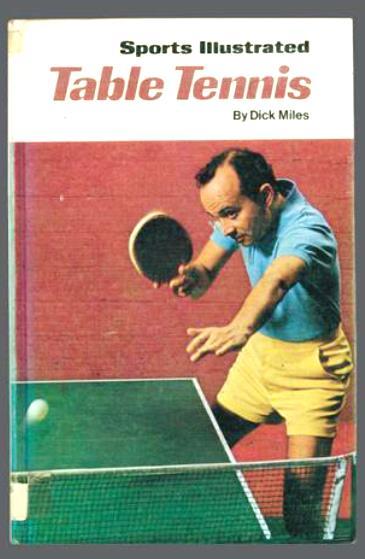
Miles wrote many articles, most notably for Sports Illustrated. This 1971 instructional article...

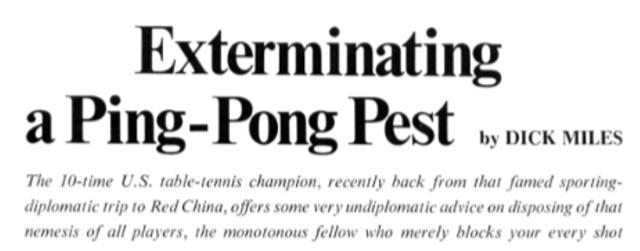
... was illustrated by noted SI artist Robert Handville



His first big article was in Calling All Boys magazine, October 1946


In the 1960s and ‘70s, Miles did table tennis commentary for Wide World of Sports and other TV broadcasts.
He appeared on several national TV talk shows, too, such as Mike Douglas and David Frost. Stipends for these appearances were small, but they were good publicity for his books and other offerings. He was able to join the 1971 U.S. Ping Pong Diplomacy group to China as a reporter.
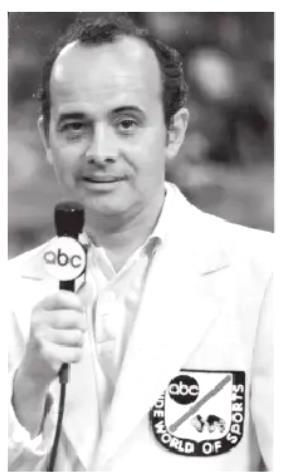
Miles partnered with Sears and Montgomery Ward for some of his name-brand products. He also imported equipment from Asia as a middleman to retailers.
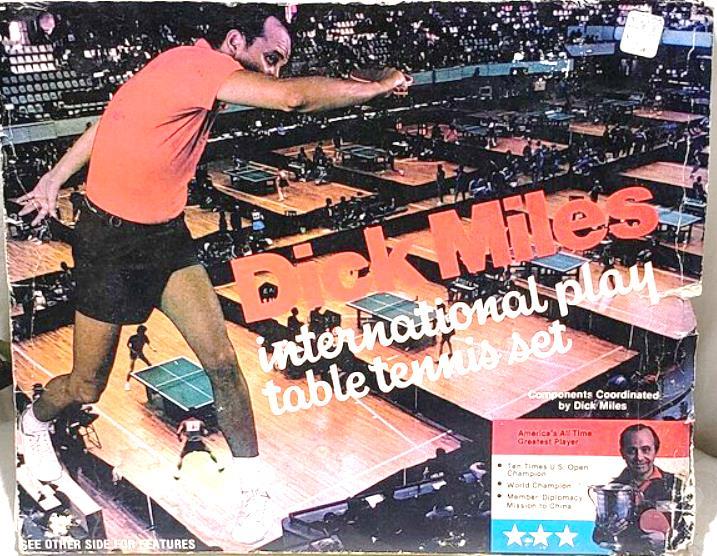

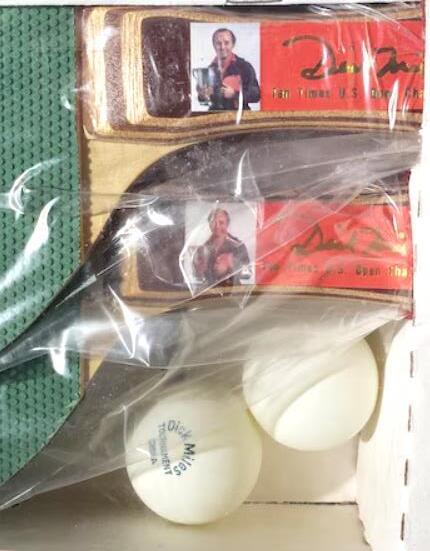
Below, the front and back of balls, 1986. That is his actual home address on the back. The incorporation date of Dick Miles Sports was January 1975.
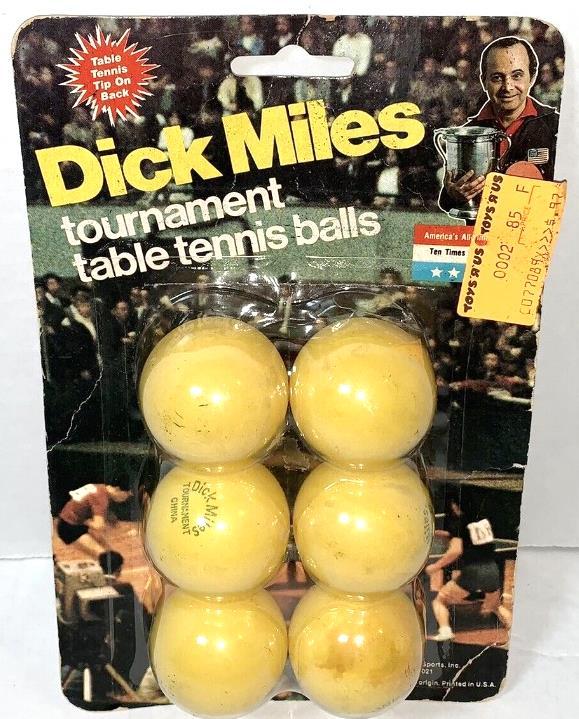
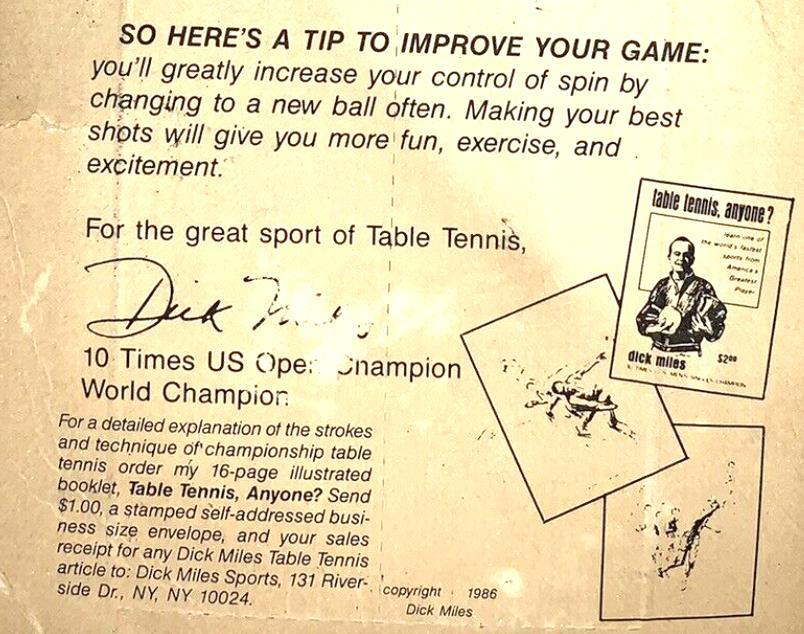

Miles’ lifelong home on Riverside Drive on the upper west side of New York City
We don’t know whether gambling was a significant income source for Miles, but it’s a safe bet he was an overall winner. In the 1940s and beyond, at the New York clubs and at tournaments, gambling was a fact of life. In some cases, the bet was really a tribute or price of admission that an inferior player, such as the younger Marty Reisman, had to pay to get on the table with Miles. Before he reached the top, Miles himself must have paid the price to fellow club member Lou Pagliaro, the national champ. That New York environment produced great champions.
Reisman’s The Money Player has plenty of good gambling stories.
The USTTA did what it could to stop betting but was ineffective. Before the 1949 nationals in New York City, the March USTTA publication stated, “Gambling is prohibited by the laws of the City of New York and by the National ruling of the USTTA. Not only will you open yourselves to penalty by the Association, but also to arrest by any of the legal city authorities who will be represented ” They gambled anyway.
In a 1954 interview (Los Angeles Times, Feb. 4), Miles said he averages about $150 per exhibition (about $1600 in today’s money). A recent four-day show in Los Angeles netted him $800, he said. In Japan, he endorsed table tennis balls for $1700 and got export rights.
In a 1962 interview (Buckingham Post, June 22), Miles said his high income year was $15,000 (equivalent to about $150,000 today). “The money isn’t great, but the life is. I’m a non-worker.”
This non-worker brought entertainment and fun into many lives. 1954


In the spring of 1950, Dick Miles was, as always, seeking a way to step up his professional table tennis career. So was England’s like-minded Richard Bergmann, who had just won his fourth world singles championship.
Their idea was a series of matches throughout England, every fall, to determine the world champion professional two-man team. They also wanted to establish a professional table tennis association, bypassing the pesky national TTAs. (Miles was under suspension at this time by the USTTA for irregular conduct during his 1949 trip to the world championships. Bergmann was about to be suspended by the ETTA for not obtaining permission for his upcoming South African exhibition tour.)
Miles wrote to numerous English arenas in May 1950. One of those letters is shown on the next page; they were probably all nearly identical. This one is to Sol Sheckman (1893-1963), who owned St. James’ Hall, a successful boxing arena in Newcastle in the far north of England. He also owned the largest independent cinema chain in England. Miles probably did not know any of that; to him, Sheckman was just the arena manager whose name he got from the town clerk.
Table tennis was not new to St. James’ Hall. On November 27, 1935, a group of international stars (Szabados, Bellak, Liebster and Ehrlich) performed there before over 2,000 spectators. On February 9, 1938, Barna and Bellak competed against local players, watched by over 2,500. English stars Adrian Haydon and Hyman Lurie did an exhibition on January 31, 1939.


Miles was only 24 when he wrote this sensible, well thought-out letter...



Unfortunately, the proposal did not go anywhere.
Meanwhile, by the way, back in the U.S. in May 1950, Marty Reisman was being promoted as the World Professional Champion on an exhibition tour with claimed number-two Doug Cartland. The pair was still using those labels on a 1955 Iceland tour.
Miles in the British publication Picture Post, March 1949

Our colleague Dean Norman of Ohio, once a top Iowa player, relates his memory of a great match. Dean, born a year after Marty Reisman (1930-2012), witnessed it in person.
To set the stage
Reisman learned the game at the feet of fellow New Yorker Dick Miles, who was five years older. By age 18, Reisman had essentially caught up. In the finals of the 1948 U.S. nationals, they played an exhausting marathon match, with points lasting as long as eight minutes not push/push/push points but drive/chop/drive/chop, with Reisman doing the driving. Miles won deuce in the 5th for his fourth straight national singles title. In 1949, Reisman was riding high after winning the English Open, but Miles brought him back down to earth with a 3-0 win in the U.S. final. Some said Reisman had let Miles take the offense too often. In 1950, they were under suspension, temporarily barred. That brings us to the St. Louis nationals in 1951...
Dean takes up the story
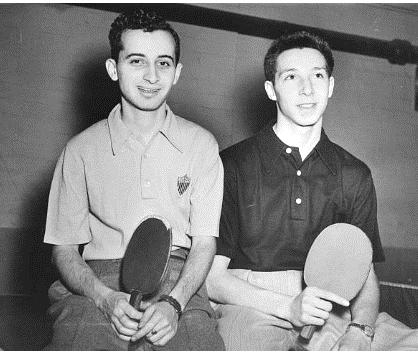
At the beginning of that tournament, I heard some top players, seated behind me, talking about what they expected:
"If Reisman is on, he could take the whole thing."
"If Cartland is on, he could take the whole thing." "If Holzrichter is on, he could take the whole thing."
There was a pause. Then someone said...
"If Miles is off...he could take the whole thing."
They all chuckled and agreed that was true. Miles was such a steady player that he didn't need to play exceptionally well to beat anybody.
In the finals against Miles, Reisman won the first two games at 15 and 18 by being patient and looking for his spots to hit. Miles, at the beginning of game 3, instead of pushing Reisman’s serve, rolled a quick backhand topspin return. It surprised Marty, and Miles got the first two points. Then Reisman decided to blast hard drives instead of hitting medium speed and waiting for an opening. He was overconfident. It seemed like he thought he would get a hot streak to catch up and win the game. He wasn't at all discouraged when he lost game 3.


In game 4, Reisman continued to swing hard and blast every ball. After losing that game, he still seemed confident.
Game 5, from the first point, Reisman went back to playing carefully. He would hit medium-speed drives to Miles' backhand until he got his rhythm right. Then he would hit a hard winning shot. Reisman led all the way and kept increasing his lead up to 17-9. (At one point, a phone started ringing. Nobody answered it quickly. Reisman paused before serving and shouted, "If that’s the Associated Press, tell them I haven't won yet." Everyone except Miles laughed. Miles was so calm and serious through the entire match whether winning or losing.) With the big lead, Reisman decided to swing hard and just put the game away. He missed on three smashes. At 17-13 he went back to carefully hitting to Miles' backhand. Reisman then hit a flat forehand kill that seemed unreturnable. But Miles just reached out with the forehand and chopped the ball back as if it were a routine shot. Reisman was leaning over the table after his follow through and saw the ball bounce in front of his nose. The great return that Miles made was not really that exceptional. I sometimes hit a return like that just because a drive happened to hit my bat at the right angle. But what was unusual was to see one shot have such an effect on Marty. He had looked like he was going to win that game easily. But that shot shook Reisman's confidence.
Miles’ close to the table defense was always great. Reisman didn't win another point with his attack. He was hitting soft drives to Miles' backhand, trying to get Miles to return a chop high. But the chops were always low, and Reisman would lift a soft drive off the end of the table. Each time he did this he shouted, "Oh no, Marty! Don't do that!" It was embarrassing to see Reisman choke like that. He swung his arm like the tin man in Wizard of Oz needing elbow oil. Then Marty finally won a point when his push dribbled over the net. Instead of saying "Sorry," he raised his arms and cheered. The audience laughed it was just Marty clowning, and funny to have him express what any player really felt on a lucky point at a crucial moment. Miles didn't smile or frown. He just picked up the ball and tossed it back to Marty. I thought Marty might relax and start hitting loose again. But he didn't. He continued to hit soft drives and lofted them off the end of the table, and shouted, "Oh no, Marty! Don't do that!!" When Miles won at 21-18, Marty smiled, walked quickly around the table, and shook hands.
(Lifetime, Miles was 10-1 in U.S. Open singles finals, winning his last one in 1962. Reisman did not make the finals again until 1958-1960, beating Max Marinko in one and then splitting two finals with Bobby Gusikoff.)
We all agree that observing top players is a terrific way to learn. In olden times, film viewings were hard to come by. So photographs were very important, especially the many publicity shots that of course showed the stars at their best. At right, for example, Dick Miles demonstrates his famous Flying Forehand, the stroke that made him a champion. Now, deep analysis of historic photos has uncovered four groundbreaking Pro Tips
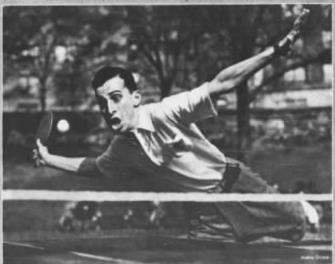
Pro Tip 1 : Devote 80% of practice time to Flying and Leaping shots.
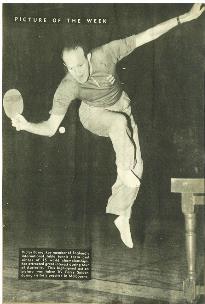
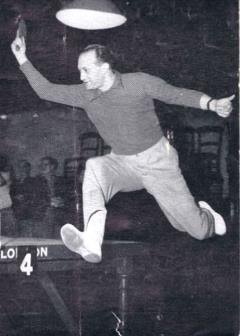

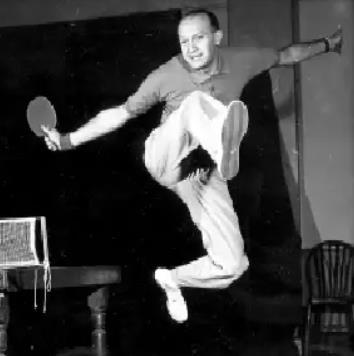



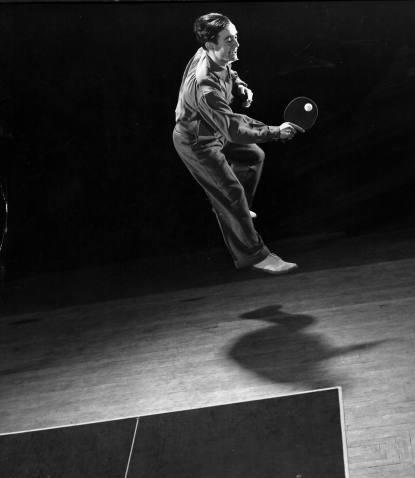




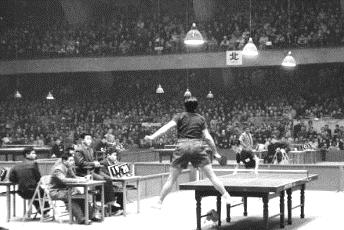
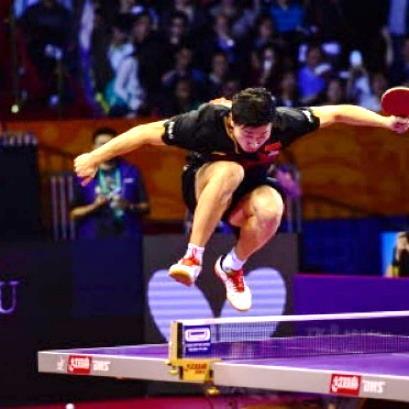
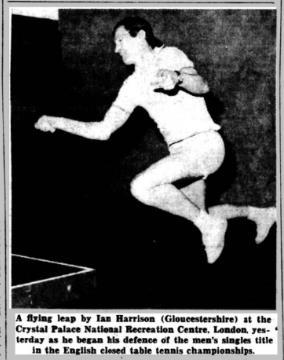
Bergmann and Laszlo Bellak both found this leaping style effective, especially when combined with scary facial expressions.
(The captions on the Bergmann publicity cards at left state that he was world champion for 11 years. He won the singles title in 1939 and the event was next held in 1947, so he was world champ 1940-46. Or at least that’s the way Bergmann saw it.)
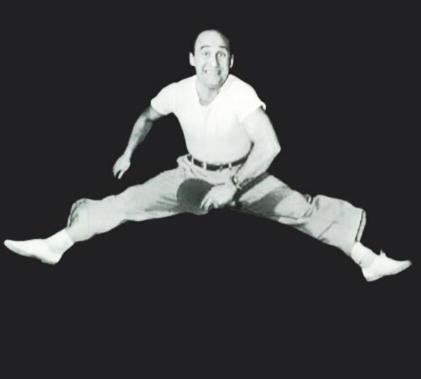
By the 1956 Worlds, however, the aging Bergmann (37) had leap-control problems and lost this quarterfinal match to Yoshio Tomita of Japan.

Pro Tip 2 : Devote 10% of your practice time to unusual positions.
Flying and leaping always carry the risk of a bad landing. Be prepared to play from anywhere.
World champion Ruth Aarons of the U.S., 1938
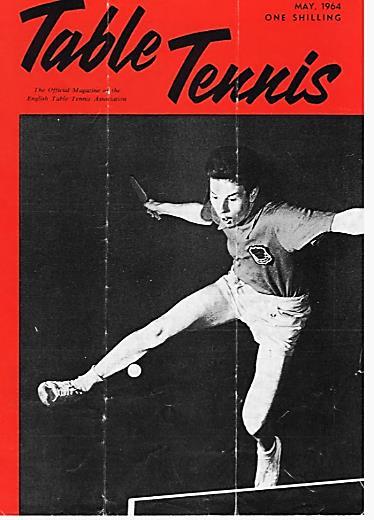

Playing on top of the table is not as easy as Denis Neale makes it look.
May 1964 English magazine

If you land awkwardly, it is important to act nonchalant, like it was planned. Note here how Mildred and Marty remain ready for whatever may come. Crafty Waldner, below right, played it differently, calling an immediate time-out.
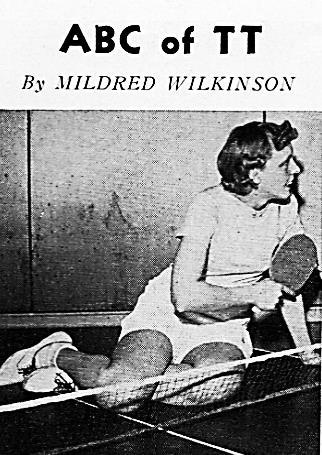

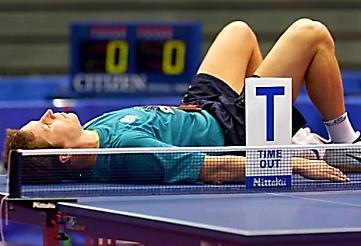
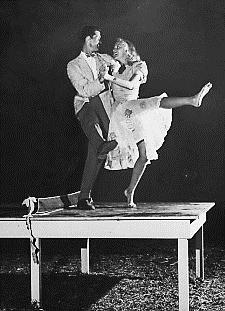
Pro Tip 3 : Avoid looking at the ball if at all possible. Focus instead on what your opponent is up to.
To train: Glue a ball to your racket and practice ignoring it, as below. Five minutes a day is sufficient.


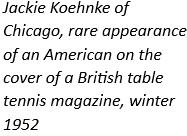
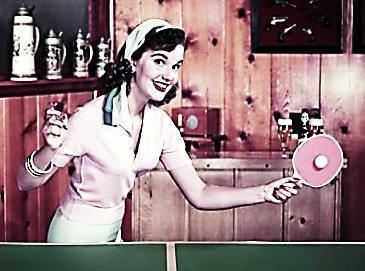

Unnamed players but world-class form
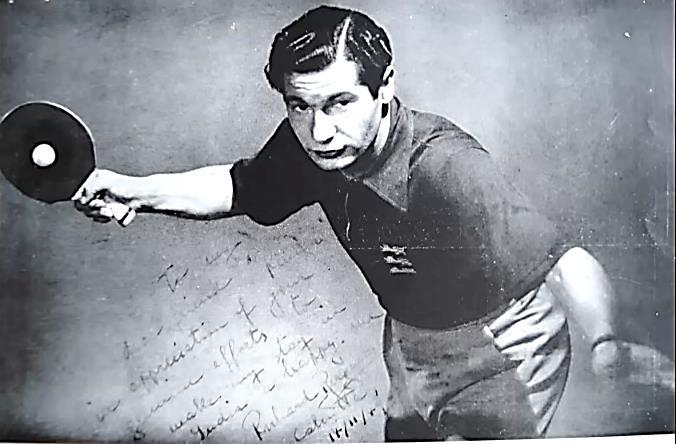
(Above right photo is courtesy of our colleague Günther Angenandt of Germany and his great Facebook site. Bergmann inscribes it, “To my dear friends in appreciation of your generous efforts to make my stay in India so happy.”)

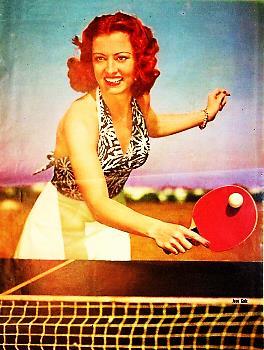
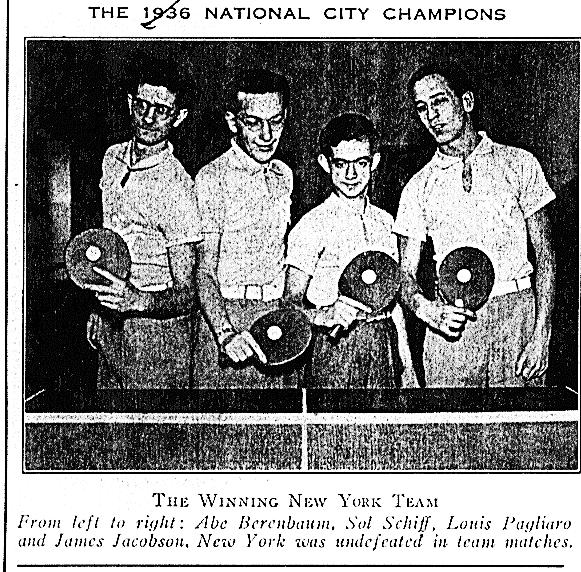
Powerful 1936 city team shows how they practice together. Three of these young men had already been U.S. national singles champion, and the fourth, Lou Pagliaro, 16, would later win that title four times.
Final Pro Tip : Practice your strokes anywhere at any time. No ball needed.
The 1935 U.S. team prepares in their London hotel for the next day’s world championships.
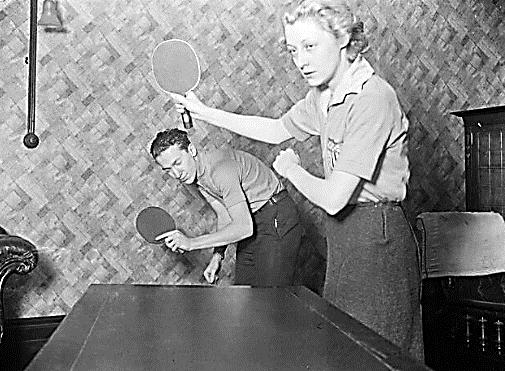

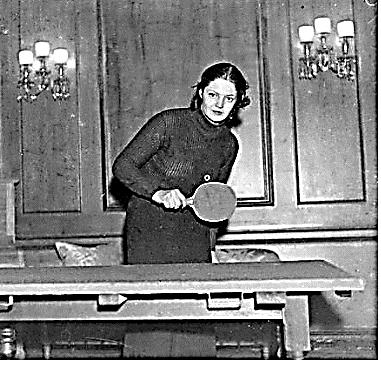
“Photo Shows Miss Helen Ovenden Practicing With Mr Sol Chiff [meaning Schiff] In London For The Mixed Doubles Tournament February 7Th 1935”
This photo of Helen, strategically cropped, made it into the newspapers, which stated that she is “making a back-hand return during practise.”


Later that day, Helen teaches Julia Ruth how to use visualization technique. (“Hammer-grip” Julia, 18, graciously agreed to be a lastminute entry, thereby allowing the U.S. to field a two-person Corbillon Cup team. She luckily happened to be in London with her famous father, baseball player Babe Ruth.)
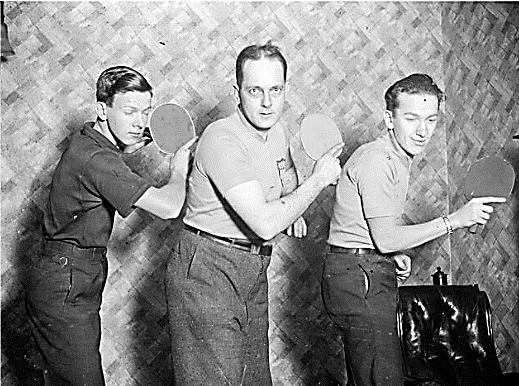

Jimmy McClure, Bill Stewart and Sol Schiff practice backhand chops.

We continue our look at the first 100 issues of Table Tennis Collector/Table Tennis History Journal. Those issues can be viewed at https://www.ittf.com/history/documents/journals/.
Issue 44 ***Page 9. Gerald Gurney discusses his contribution to the BBC TV show Eureka, an educational series about the invention of everyday objects. The show ran for 32 episodes over four seasons. Season 3, episode 5 included table tennis and aired April 19, 1985. I have not been able to view that episode, but episode 6, a summary of previous shows, has 22 seconds of the table tennis episode that can be viewed at Eureka, 20:20 to 20:42. Here are two screen shots from that, when a cork struck with a cigar box lid finds an unfortunate target.
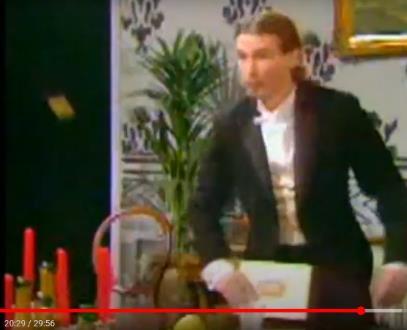

Issue 44 ***Page 12. Shows a rare 1930s Becker bat (below) with unusual pips. The P. Becker & Co. story: Started as a luggage company, the firm is enshrined in the USATT Hall of Fame primarily for its promotion of the sport under William V. Schnur (1881-1966) in the 1930s. (His daughter Trudie had several important U.S. tournament wins in that decade.) The firm brought the famous English Leyland rubber to the U.S., used by most top players of the time. They also sold Coleman Clark balls and bats.
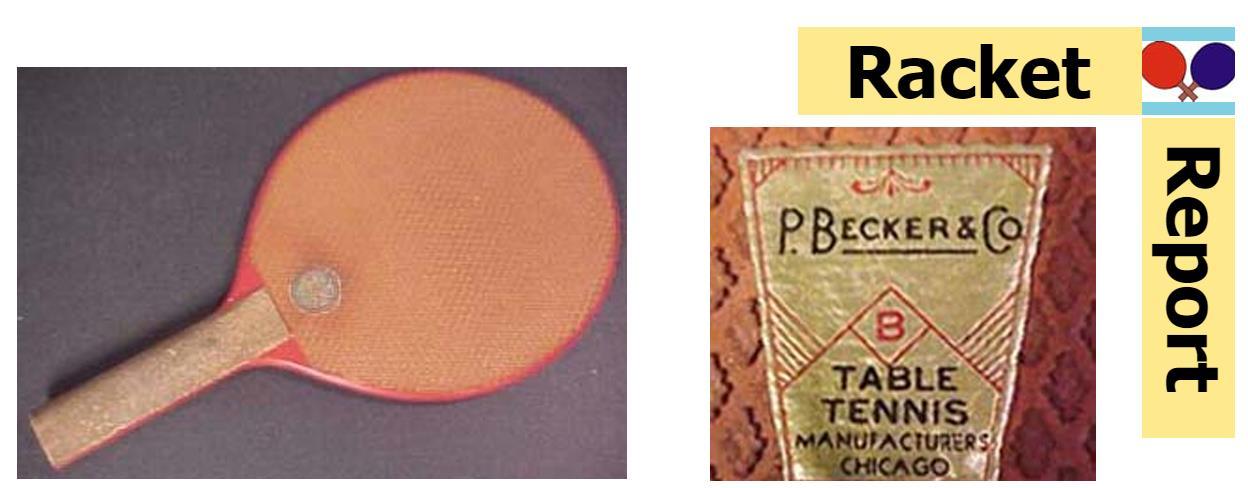
Issue 45 ***Cover article shows a postcard discussing ping pong, sent by French nationals from China in January 1902, demonstrating that the game had arrived in China by then. But this is no great revelation. Readers of the North-China Herald knew that table tennis entered China in the first half of 1901. See the
article When Ping Pong Came to Asia in Issue 58, p. 6.
Issue 45 ***Page 9. The source of the mystery image at right remained a puzzle, with some mistaken speculation, until it was solved in Issue 71, p. 36.
Issue 45 ***Page 21. Shows photos of 36 top players of the day grouped by country, with facsimile signatures, from a 12-page booklet published at the 1952 world championships in Bombay. See page 33 of this issue for the full booklet with 108 players from around the world.



Issue 46 ***Page 6. Discusses pyrographic bats. Many of these were do-ityourself homemade artwork, and at least one company supplied blanks bats supposedly made especially for woodburning. The 1903 catalog page at left is from C.C. Lowell, Worcester, Massachusetts.
You could also buy bats with drawn patterns to guide your woodburning, such as at left from the catalog of Thayer and Chandler, Chicago.
Ready-made bats were popular, too, such as these at right offered to retailers in the June 26, 1902, issue of Geyer’s Stationer. The center example went for $217 in a 2008 eBay auction, as reported on page 11 of Issue 50; the buyer may have thought it was an original, one of a kind.

Issue 46 ***Page 10. Gerald Gurney discusses his celluloid balls that have a rattle inside, asking if they were made for players with sight disabilities. Answer: These are probably just children’s toys. If you find one in an old table tennis set, the ball was probably not original to that set.
Issue 47 ***Page 4. Purports to explain how celluloid balls are made. But is it just possible that Life magazine uncovered their true origin in its October 16, 1902 issue, accompanied by an actual drawing? We show it at right.
Newspapers in 1888-1892 carried many ads for celluloid balls as children’s playthings, both in the UK and USA.

Either early table tennis inventors simply failed to consider them, or the ball qualities made them unsuitable for that purpose. A short-lived 1894 Table Tennis included celluloid balls (uncovered in our September 2023 issue), but then we know of nothing until 1900, when a London athletic group introduced celluloid balls to their table tennis, which they then called Ping Pong.
This 57 mm celluloid ball might date to the 1890s.

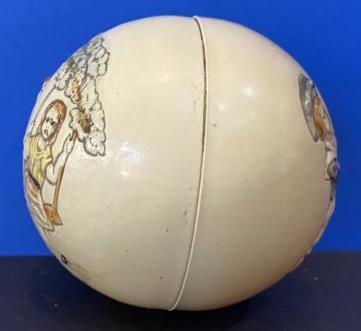
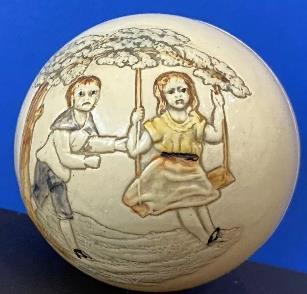
NY Evening World, May 1891
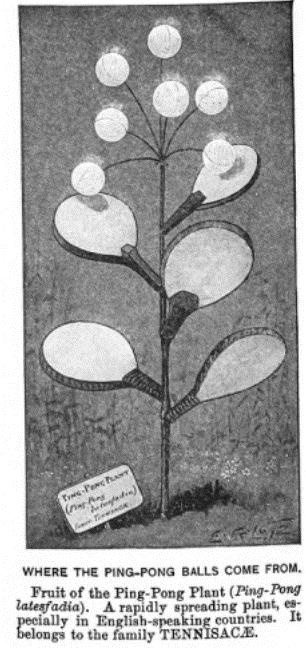

Issue 47 ***Page 12. Shows an envelope with drawings of Ping Pong shoes, below left. On the right is another one that showed up more recently on eBay, also sent in 1903 but in this case with only a third-class 1-cent stamp. This meant it contained only a printed advertising circular, sent to the Maine shoe-store owner Levi Libby.
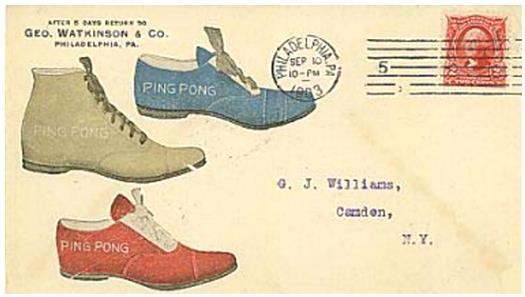
George Watkinson, the sender, enjoyed a long career in the rubber shoe business and filed many U.S. patents in that line in the 1870s and 1880s. By replacing leather and canvas with rubber, either wholly or partially, shoes and boots gripped the ground better and were water resistant. Tennis shoes of this type were very popular in the 1890s and were used in many activities, not just tennis. To take advantage of the Ping Pong craze, it made sense to produce similar shoes, though the 1903 postmarks indicate Watkinson may have been late to the game.
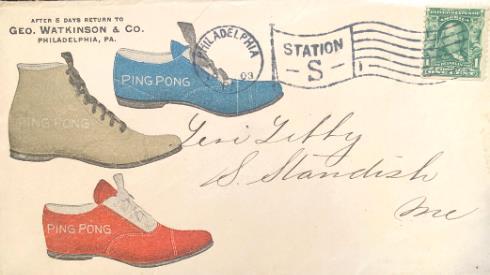
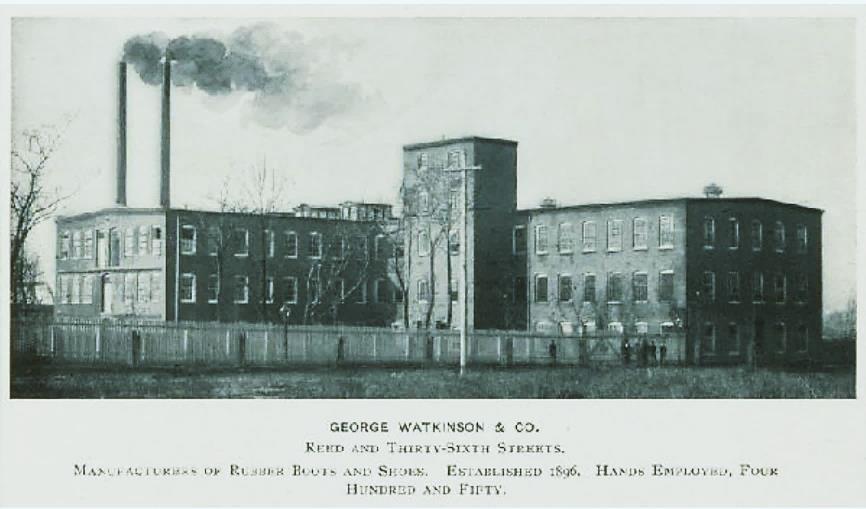
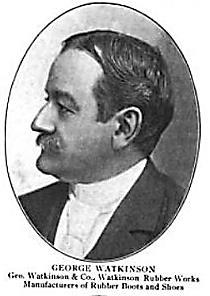

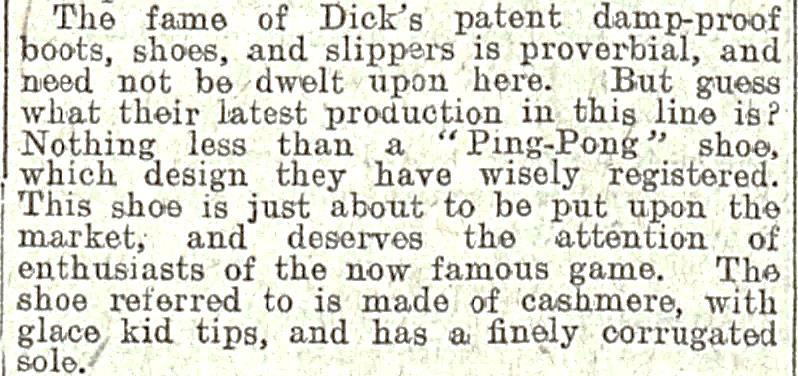

Issue 48 ***Page 3. Notes that the original Corbillon Cup was lost during WW II. In Table Tennis, February 1947, English international Jack Carrington said it was last seen in German hands in 1939
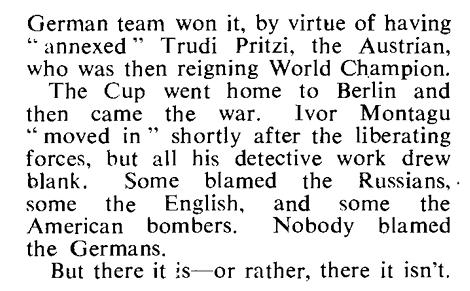
Almost every source states flatly that the Cup was donated by Marcel Corbillon, president of the French Federation, in the same way that the Swaythling Cup was donated by Lady Swaythling. That is quite misleading. The Cup was financed by the 1933 French exhibition tour of Barna, Bellak and Verger, spearheaded by Corbillon. It was later decided to name the Cup in his honor, against his objections. See Issue 90, p. 18, for the full story.
Issue 48 ***Page 6. “Ping-Pong Bling-Bling” discusses early jewelry inspired by the game.
See page 48 of this issue, where we

Separately, this unusual 1902 locket features two different racquet types. One could call them a ping pong and a tennis, or alternatively two different kinds of ping pong racquets.

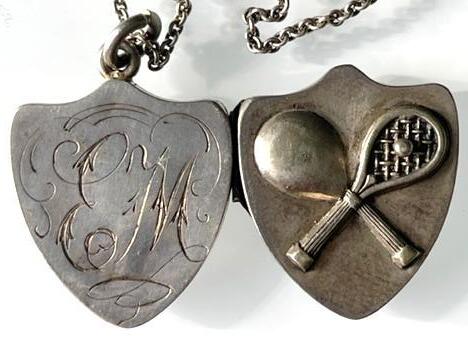
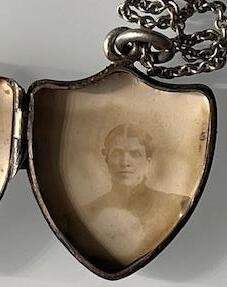
Issue 49 ***Page 4. Mistakenly dates Cup and Ball Tennis to the 1870s or 1880s. This set actually came out in 1891, and the balls shown are not “the first celluloid balls ever made,” though they are early and seemingly rare.
Issue 49 ***Page 6. “The Fashionable Fanatic” discusses ping pong fashions of the 1902 era. At right is another example in an ad from Illustrated Milliner, June 1902.
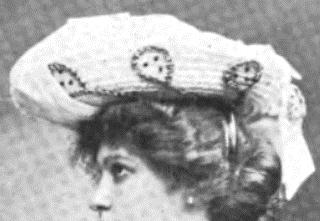
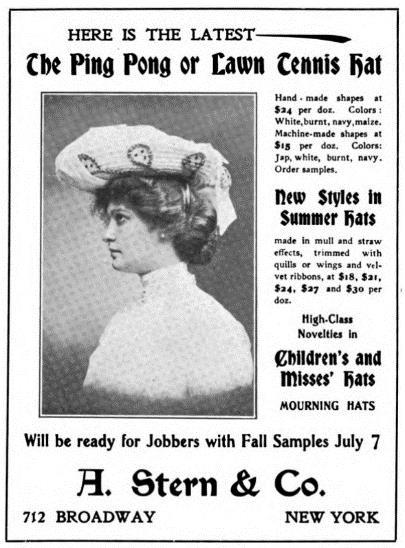
Issue 49 ***Page 9. The Music of Table Tennis, an update by colleague Alan Duke, lists a 1976 recording by the world doubles champions Kjell Johansson and Stellan Bengtsson of Sweden. You can listen to their two catchy tunes at Ping Pong is Tops and Ping Pong Around the World on YouTube. Neither was a hit, however, and they quickly returned to their original career.

Issue 50 ***Page 7. “Party Time” article noted that ping pong pillows were among prizes at 1902 ping pong parties. While ready-made pillows were available, many people enjoyed embroidering their own, usually with a preprinted design as a guide. An example is the partially embroidered pillow top below, measuring a large 20 inches by 24 inches.
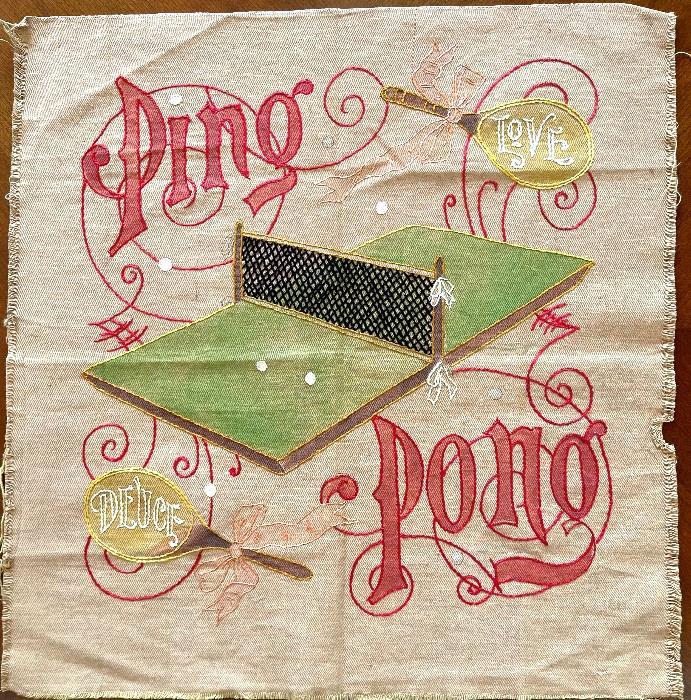
Reward Please let us know if you find the below:
Dry Goods Reporter, August 16, 1902



Pillow at right is from a 1902 Needle and Hook magazine. Note the suction-cup ball pickup device. This type was mentioned in newspaper articles of the time, as discussed in Issue 47, page 7, but I have never actually seen one. At left, from a 1902 Spalding catalog, one is pictured on the far left.
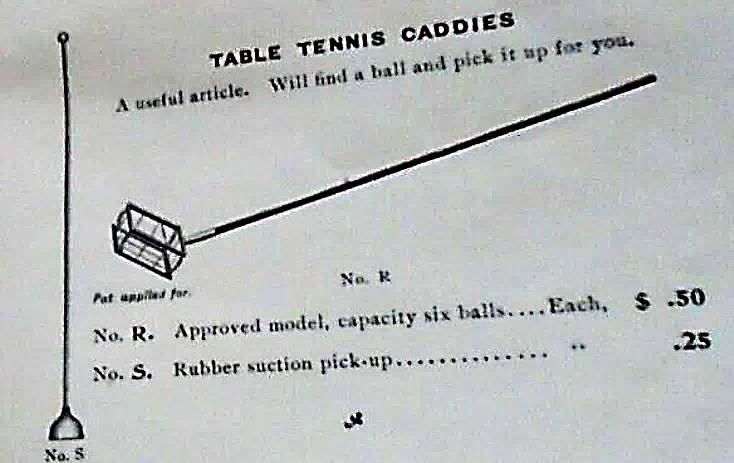

Issue 50 ***Page 11. Asks whether a 1950s sponge racket with the label Sporthaus Fritsch is connected to the Austrian star Waldemar Fritsch. Answer: Unlikely. This Zurich company was founded in 1903 and was best known for its winter sports equipment.

Issue 51 ***Page 7. Hazards a guess that this silver miniature table tennis bat with gilded interior, less than three inches long, is a monocle holder.
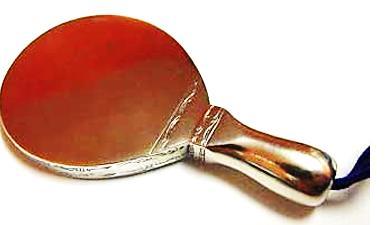
In Issue 74, Alan Duke showed the design registration


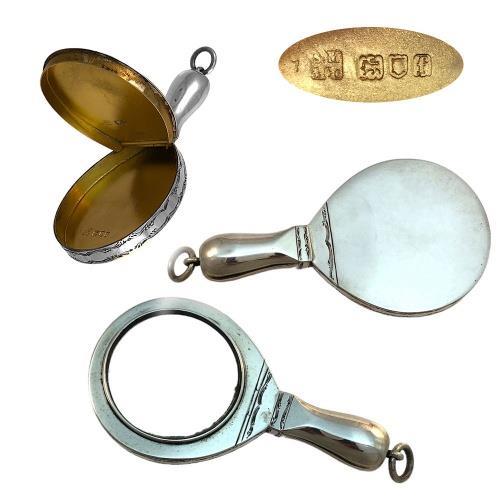
The drawing states that the bat body contains a tube, but that seems physically impractical. Our actual piece has no such tube, nor does the variation above with a convex magnifying mirror. They were likely used as compacts containing a small powder puff. Mordan made many gold and silver objects but was best known for its mechanical pencils (above right), which the firm was the first to patent in 1822.
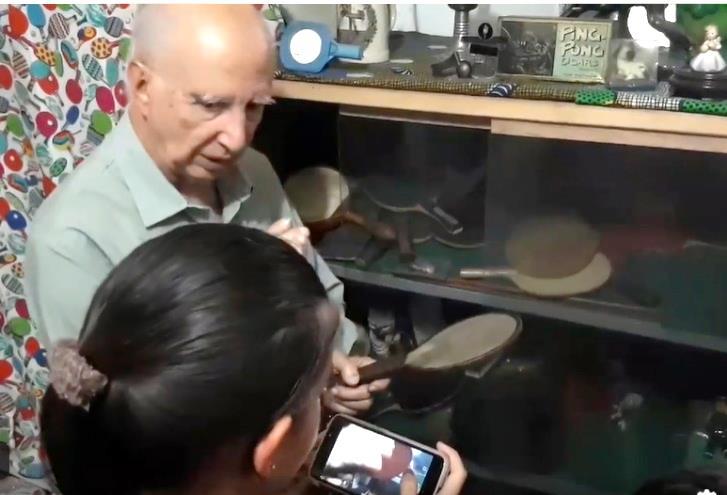

Issue 51 ***Page 10. States that our colleague Jorge Arango of Colombia will establish a table tennis museum. See page 47 of this issue for an update.
Issue 51 ***Page 23. Misidentifies one player in the Mystery Photo and gives no answer to the other mystery question: What is the event?
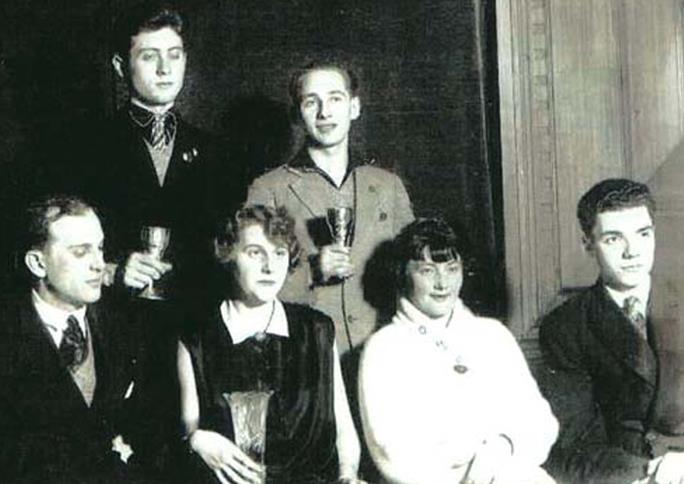
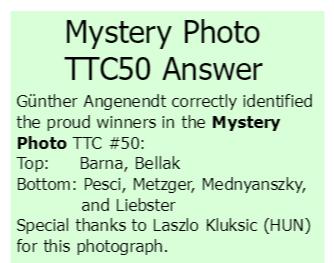
The tall gentleman is not Barna. It is Sandor Glancz, the talented Hungarian who would later emigrate to the U.S. and do exhibitions with old friend Bellak, Ruth Aarons and others. As for the event, the perfect match is the 1928 German Open

Note that the editor thanks Laszlo Kluksic for sending the photo. Kluksic was the son of Mednyanszky, about whom he wrote a book in Hungarian. His father was a player, too.
Issue 52 ***Page 5. Gerald Gurney shows three fretwork pieces (below left) and states that they cannot be fans because the holes would make them ineffective.
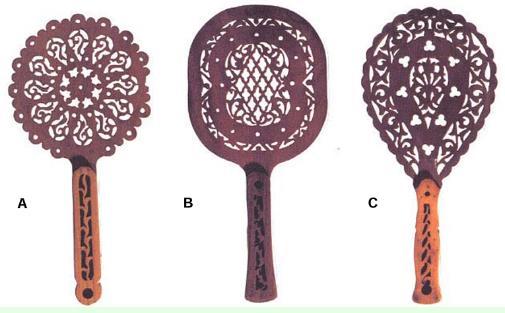
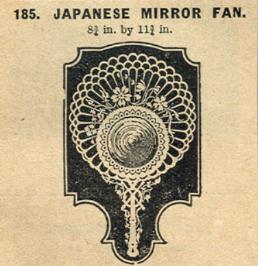

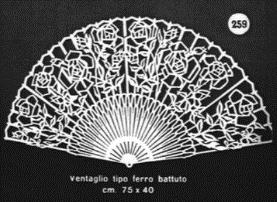
I would say they could have been fans, in view of other fretwork fans of the day such as these three.
Yet they could have been table tennis bats, perhaps even those advertised below in the Yorkshire Evening Post, December 6, 1902. Or maybe this seller simply reclassified slow-selling fans to take advantage of the popular game?
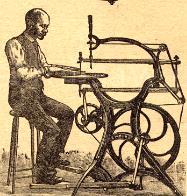
Mr. Gurney also asks if they could have been “pressed out with a machine.” I believe they were always made with a scroll or fretwork saw, such as at left, not stamped or pressed out. Required a meticulous, skilled and patient operator!
Issue 54 ***Page 4. Shows this medal that reads “Europe Cup Competition (Men) England 19481949.”

The story behind it: In 1939, the ITTF was pondering a switch to a zone system for the Swaythling Cup. As a test, they devised the Europe Cup, based on the tennis Davis Cup system. The war got in the way, but finally in 1946 they went forward with a two-zone Europe Cup, with separate events for men and women. It lasted three seasons. At the February 1949 AGM, they terminated it, “in view of the experienced poor financial results at ties between countries of great disparity of strength.”
Here are the winners (who got a free pass to the following year’s final challenge match):
1946-47 East zone champion Czechoslovakia (Andreadis, Vana, Stipek) beats West zone champion France 5-0.
1947-48 Slovakia (also known as Czech B) beats Czech 3-2, as Vana loses to both Marinko and Tokar.
1948-49 England (Barna, Leach) beats Slovakia 3-2 on May 9. Frantisek Tokar, 23, before a sold-out crowd of nearly 2,000 in his hometown, Bratislava, lost -18 in the 5th to both Englishmen.

1946-47 England (Franks, Dace, Blackbourn) beats Czechoslovakia 6-1.
1947-48 England beats Czech 5-0.
1948-49 Hungary 5, England 2, as Farkas wins all three of her matches, May 12 in Budapest.
Issue 55 ***Page 16. Yao Zhenxu, who in 2010 is called the ITTF Director of the Museum of Shanghai, writes about an exhibit at DHS headquarters in Shanghai. I would love to see the postcard described as showing table tennis players and mailed from China to Europe in 1901. I recently wrote twice to Mr. Yao but received no response. I am wondering whether that postcard was accurately described and whether the DHS exhibit is still there.
A special booklet produced at the 1952 Bombay World Championships showed top players sorted by country. TTC Issue 45 displayed 36 of them; here we give all 108. The Indian postage stamp and return address on one page (see below, bottom left), along with destination address on another page (bottom right), point to this being mailed from India to English star Diane Rowe in Middlesex, England. But it was ultimately intended for the great Romanian player and coach Farkas Paneth (misspelled twice as G. Peneth), whose name is written (bottom left again) along with the names of the three Romanian women whom Paneth coached to the 1952 Corbillon Cup silver medal. Rowe authographed it (below, top right) under her photo (“Hoping to see you in many more championships. Best wishes...”) before presenting it to Paneth. He much later gave it to our colleague Günther Angenendt of Germany, who visited him at Cluj-Napoca for one week in 1994. It is through Günther’s courtesy that we view it today.

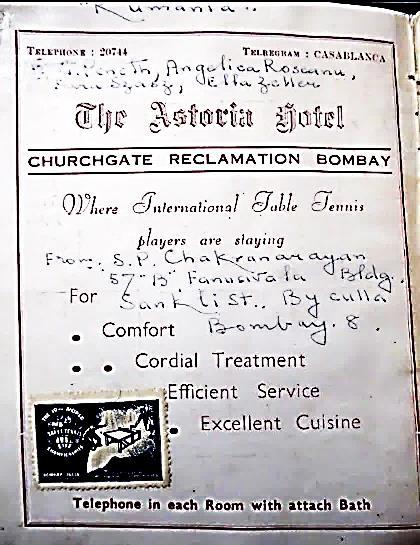
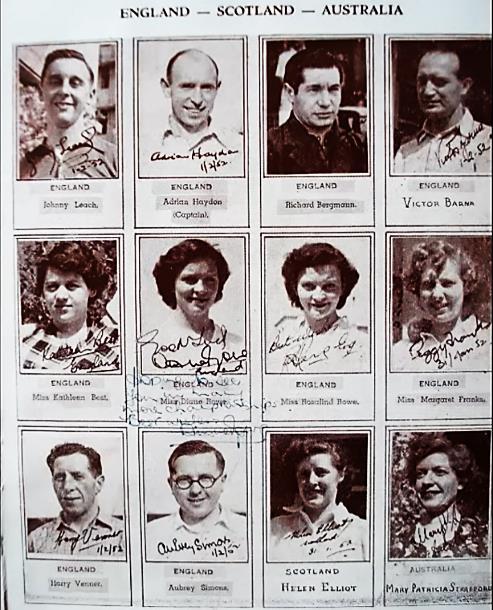
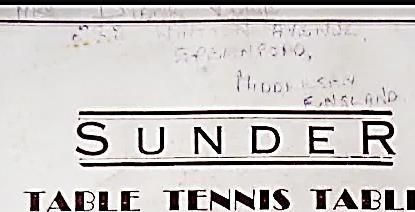
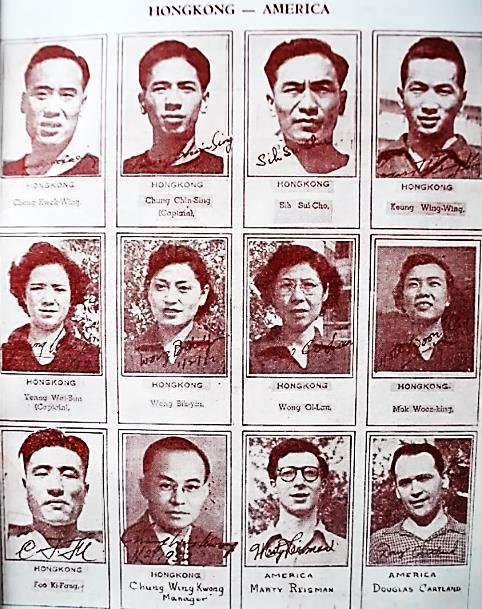




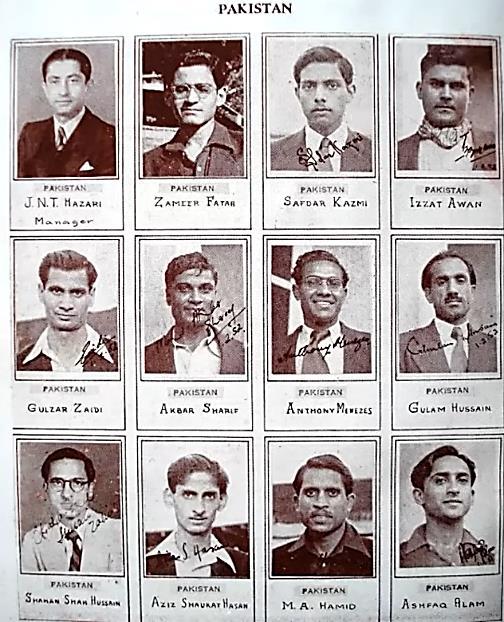


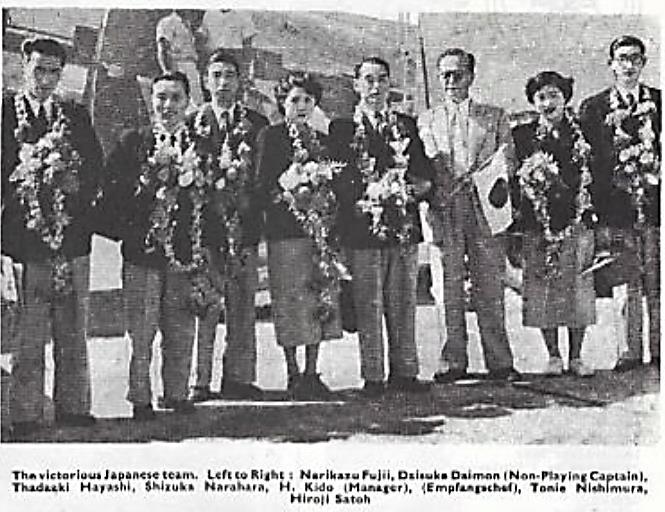
The champion and the organizer... ...37 years later
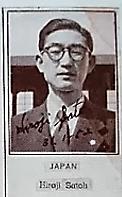


Card sent “with best wishes from the English team in Bombay.”
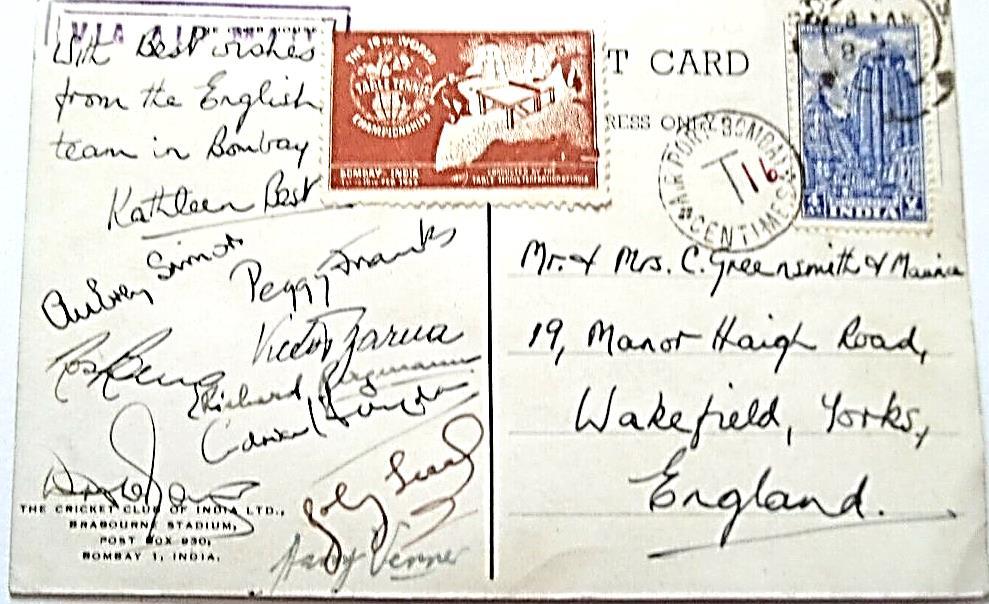
Our New Zealand colleague Robin Radford kindly contributes the following
Remembering…….
The long article in Table Tennis History in January 2024 regarding Richard Bergmann brought back some memories for me.
Bergmann (photo at right) toured New Zealand in 1949 with Victor Barna, and again, alone, in 1954 when he played the best local players in Canterbury, Wellington and Hutt Valley centres and demonstrated some of his trick shots and novelty audience participation routines. I had the pleasure of seeing him play in Christchurch in the 1954 visit and was fortunate to be invited to an after-match supper to meet him. From all accounts Bergmann was a nice guy. I can remember nothing of the conversations that night but there were certainly no negative vibes whatsoever.
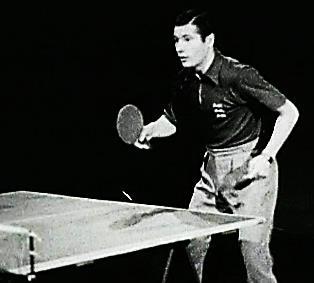
That gathering was at the home of the Williamsons. Phil the father was an administrative stalwart of the local Canterbury Association. Son Brian was ranked number 7 in NZ and daughter Joyce was ranked number one woman in NZ that year. Joyce Williamson (seen 2nd to left in photo) had a very orthodox attacking game (and defensive when necessary). In an amazing performance in Auckland during a NZ tour by the Rowe twins in 1953, she pulled off an upset win over Diane Rowe, and in Wellington she gave Rosalind Rowe a hard game, losing 20-22, 18-21.

I had the pleasure of meeting Diane Scholer (nee Rowe) when she visited NZ for the World Veterans Championships in 2014.
Joyce’s brother Brian Williamson (seen below with me and others) was also a very orthodox player whose strokes were near textbook perfect. I first joined a table tennis club in 1950, my first year at high school, in Christchurch. In those early years Brian coached me in the open air on my parents’ back lawn. He instilled in me the forehand chop defensive stroke by making me commence the stroke way way back and following all the way through as far as possible with the top of the blade pointing to where I wanted the ball to go. This action of course over time reduced considerably but certainly put one on the correct course.
Interestingly, in the later 2000s I read a book called Bounce by Mathew Syed, English number one table tennis player for many years, journalist, broadcaster. He describes how a top Chinese coach in 1992 had him repeating the stroke for two months – played with long sweeping arc, starting from the right ear and finishing a few inches above the ankle. So 50 years after Brian it was still a valid practise exercise.

I have collected table tennis cartoons etc for many years, a sample of which can be seen at http://www.ttnzarchives.org.nz/humour_001.htm . I now have approximately 1,900. They range from Disney, Sporting Sam and many others plus the wacky Gaston Gaba. Some years ago, Alan Duke of England and I started to exchange emails from time to time and he supplied me with some Punch cartoons. What a great job he does with all his research. It was very pleasing to finally meet him at the World Veteran Champs in Auckland in 2014. Also most helpful was Jorge Arango of Colombia who, when we exchanged cartoons, colourised mine.
Robin Radford
Life Member & Hall of Fame Member http://www.ttnzarchives.org.nz/hall_of_fame/hof_2014_p37_38.pdf Table Tennis New Zealand.

At NZ House in London prior to sailing for Australia & NZ tour. Victor Barna, Mrs Suzy Barna, Rt Hon W J Jordan (NZ High Commissioner), Richard Bergmann, Corti Woodcock.
NZ Men's team versus Barna & BergmannChristchurch 26/9/1949 - 3rd test. L/R: J H Lauder (Wellington), H Chapman (Wellington), Richard Bergmann, Victor Barna, R A Algie (Auckland), L M Wilson (Wellington)
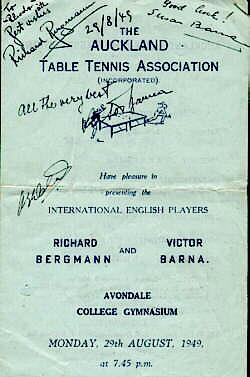
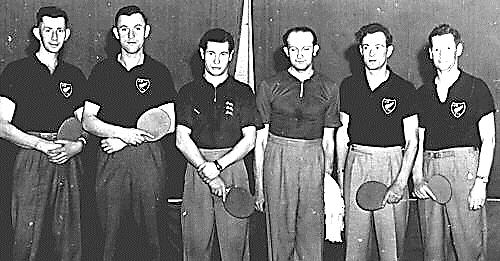
A one-minute film from the 1949 visit can be seen at: https://teara.govt.nz/en/video/41054/table-tennis-demonstrationmatch-1949
Scenes from that film
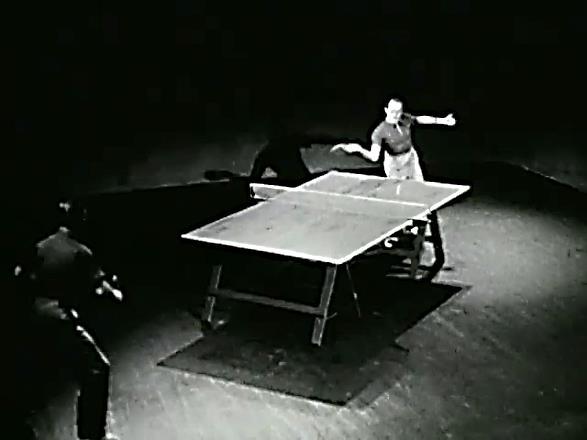
Bergmann defends against backhand attack from Barna’s forehand corner.
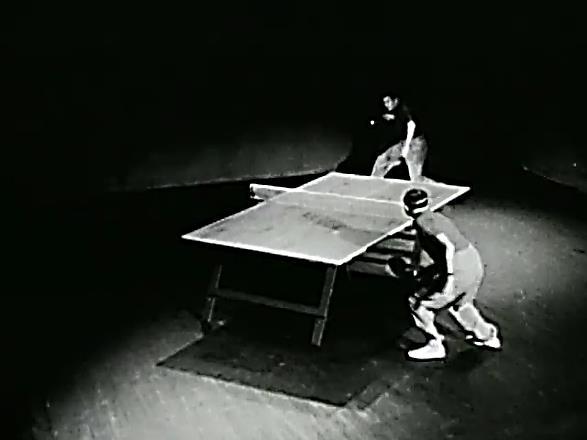


 Game 1
Game 2
Barna won.
Game 1
Game 2
Barna won.
Our colleague Dr. Fabio Colombo has written a second table tennis book in the Italian language. The title translates in English to Broken Rackets
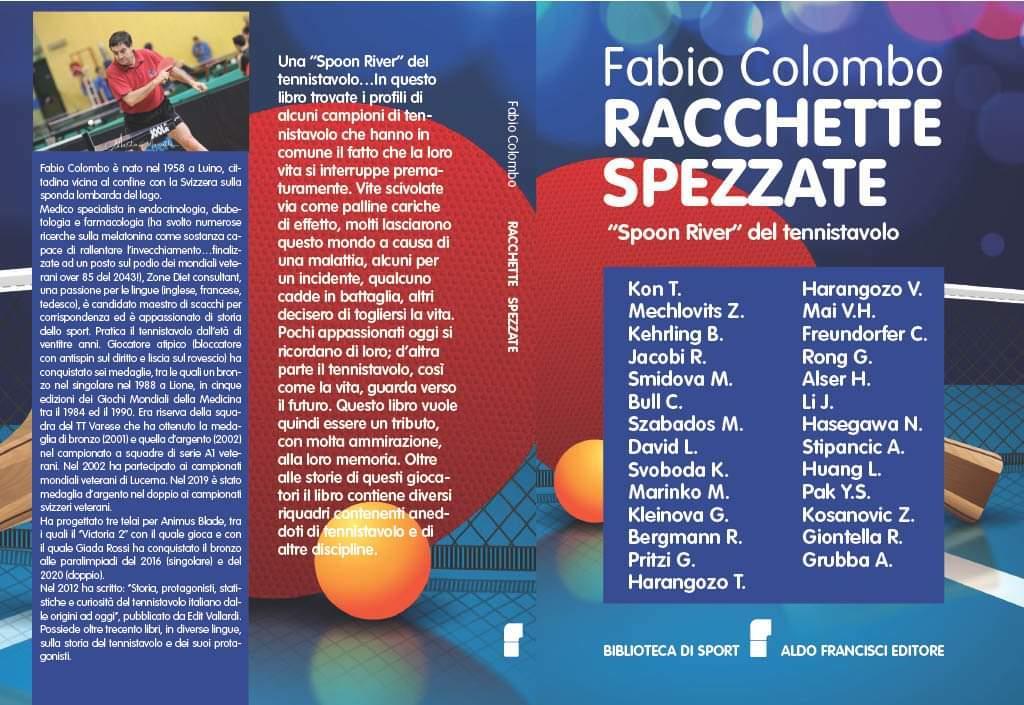
Fabio describes it this way
A table tennis Spoon River. In this book you will find the profiles of some table tennis champions who have in common the fact that their lives were interrupted prematurely. Lives slipped away like very spinny balls, many left this world due to illness, some due to an accident, some fell in battle, others decided to end their own lives. Few enthusiasts today remember them. On the other hand, table tennis, like life, looks towards the future. This book is therefore intended to be a tribute, with much admiration, to their memory. In addition to the stories of these players, the book contains several boxes containing anecdotes from table tennis and other disciplines.
By Spoon River, Fabio is referring to the 1915 book by Edgar Lee Masters, a collection of epitaphs of the citizens of a fictional small town.
The interesting list of contents, here translated into English, is ordered by birth year of the players
o Takashi Kon ? - ?
o Jiro Sato: the importance of honor
o Mechlovits Zoltan 1891-1951
o Kehrling Bela 1891-1937
o The Wimbledon champion fell in France
o Jacobi Roland 1893-1951
o Table tennis and tennis
o Smidova Marie 1907-1965
o Bull Charles 1909-1939
o Szabados Miklos 1912-1962
o Table tennis = playing chess while running a hundred meters
o David Lajos 1913-1944
o Svoboda Karel 1915-1943
o Fallen during the war
o Marinko Maks 1916-1975
o Kleinova Gertrude 1918-1976
o Bergmann Richard 1919-1970
o Let's abolish the time limit
o Pritzi Gertrude 1920-1968
o Endless games
o Harangozo Tibor 1922-1978
o The mysteries of sponge
o Harangozo Vilim 1925-1975
o Mai Van Hoa 1927-1971
o Reiter Toma: an honest table tennis worker
o Freundorfer Conny 1936-1988
o Rong Guotuan 1937-1968
o Falun Dafa (Falun Gong)
o Ping pong diplomacy
o Alser Hans 1942-1977
o The rackets with the stickers
o Li Jingguang 1947-2000
o Hasegawa Nobuhiko 1947-2005
o 1955: The Japanese world champions played in Rome
o Stipancic Antun 1949-1991
o I was there too in Sarajevo
o Huang Liang 1954-1999
o Here come the long pips
o Pak Yung Sun 1956-1987
o The story of Tomie and Shizuka
o Kosanovic Zoran 1956-1998
o When rubbers could be the same color: Hilton's feat
o Giontella Roberto 1956-2016
o The first China - Italy meetings
o Grubba Andrzej 1958-2005
o The most titled
o For peace in the former USSR: portrait of Zoja Rudnova
Fabio: “The book is not available on Amazon; you have to search the internet. I think Libreria Universitaria is the best place to buy it.”
At right is his first table tennis book, a comprehensive history of Italian table tennis published in 2013.
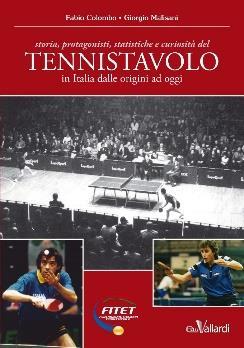

Some time ago Chuck asked me to write about my collection and then I saw Fabio’s fabulous museum in TTH98 and, I thought, how can I ever compete with that? Well, I can’t, of course! But what I can do is to describe to you how I became a collector and how the collection has evolved over the years.
I became a table tennis player over fifty years ago and am still playing for the club I founded in 1973 (the 50th anniversary was celebrated in June 2023) in my local league. I reckon that Cippenham Table Tennis Club (www.cippenhamttc.co.uk) does more to define me as a person than anything else and, being an avid record-keeper, it was natural that I should become the archivist both for the club and my local league. Another of my interests is history and so when I witnessed Gerald Gurney’s superb exhibition at an event in 1992 it encouraged me to create my own collection of historical artefacts. It was a slow start as I was looking in the wrong places. This was in the years BE (before Ebay!) and so the source had to be antique fairs and shops. My trawls around the local fairs provided me with nothing and it was not until I decided to venture further afield and widen my search to London that I finally had my first success. In late 1993 I found my first early 1900s set, a rather battered Bussey set, in the massive occasional antiques fair at Alexandra Palace. It was so nondescript that I was quite nervous about showing it to Gerald who I had arranged to meet at that fair. A few weeks later, however, my luck changed and my first ever visit to the antiques centre of London, Portobello Road, yielded my second boxed set, the Jaques Ping-Pong or Gossima top of the range Society set in a handsome mahogany box with, joy upon joy, a pair of ball pickers. Thirty years later, these are still my only ball pickers and this set is still my pride and joy!
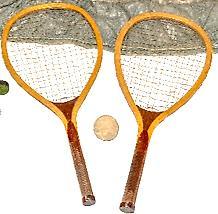
I soon gained, through subsequent visits to London, quite a decent collection of stuff from the early 1900s and that period of history was always my main focus. Visits to the monthly postcard fair in Bloomsbury also yielded a plethora of early postcards. Then, in 2001, I went to the auction of Terry Vance’s collection and bought fifty-three lots, about half of which were destined for my collection and the other half acquired for the English Table Tennis Association who had provided me with a budget to spend on their behalf. I met Michael Thomson at that auction where I was beaten by him for a collection of early postcards. Afterwards, though, I negotiated with him to acquire some postcards that were missing from my collection and were surplus to his requirements.
Ebay became my main focus, but my collection had matured over the decade or more since I started and in time it became difficult to find items that would enhance my collection and that were also within my budget. Some years passed during which I acquired very little and then I began, a few years ago, to branch out into more modern stuff, you know, the 1930s to 1950s (!), and build a collection of hard bats from that era. This is still very much work in progress. However, I have not yet ventured forward into the sandwich bat era and I doubt I ever will.
At the time of writing my collection features:
92 boxed sets including 71 from the 1900s and 21 from the 1920s onwards
103 battledores, including those in boxed sets
17 strung rackets, including those in boxed sets
160 wooden bats with various coverings, mainly from the early 1900s, including those in boxed sets
29 pimpled-rubber-faced bats from the 1930s to 1970s, mostly 1930s to 1950s
2 sponge bats from the 1950s
A variety of net and posts sets, including several stand-alone versions
Over 120 books including most of those that were published in the 1902 era
Over 70 of the early postcards from the early 1900s including many complete sets
A sampling of early jewellery, metal items and objet d’art
Many cartoons and articles from early publications, especially Punch
12 original MAROC cartoons
A huge number of tournament programmes mostly acquired at the Terry Vance auction
A large number of magazines including a nearly full set of ETTA journals
A good number of pins from World and European Championships
4 pieces of sheet music from the early 1900s
Various other bits and pieces
I have exhibited my collection only three times. The first occasion was in 2002 when my local league organized a hard-bat tournament to celebrate the centenary of the first ever ping-pong tournament held in my hometown of Slough. The audience was a mere twenty or so people! The second was again at my club but the occasion was an interview I did for a TV show. The programme was called “The Ball’s in our Court” and was shown on UKTV Blighty channel in 2011. Table tennis was featured as one of sixteen sports, four each during four one-hour long shows. The featured sports were those that originated in Britain and were then exported to the rest of the world who then soundly beat us at them! I had been invited as the “expert” on the origins of table tennis and I used items from my collection as demonstration props during my interview. The third time I exhibited was the occasion of my club’s fiftieth anniversary last summer.

A small part of my collection being used as demonstration props for a TV interview in 2010
I have created a Flickr site for my collection: Graham Trimming's Origins of Table Tennis Collection’s albums | Flickr plus another for photographs that I took on my visit to the International andChinese Museums, Shanghai in September 2019: Table Tennis Museums Shanghai September 2019 | Flickr

My first ever acquisition: a Bussey set c. 1902 with typical twisted gilded posts, wooden bats with nicely shaped handles and a badly battered box
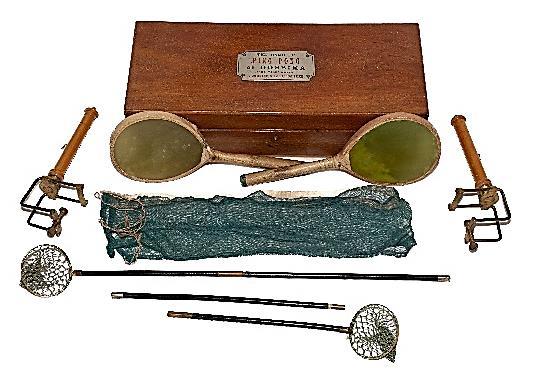
My favourite set: Jaques’ “Ping-Pong or Gossima” Society set in mahogany box and with rare ball pickers, 1902. My second-only boxed set acquisition

One of my newer acquisitions: one of 19 Jaques’ sets in the collection but this one's net and posts are in mint condition and it also includes the rules leaflet, c. 1902
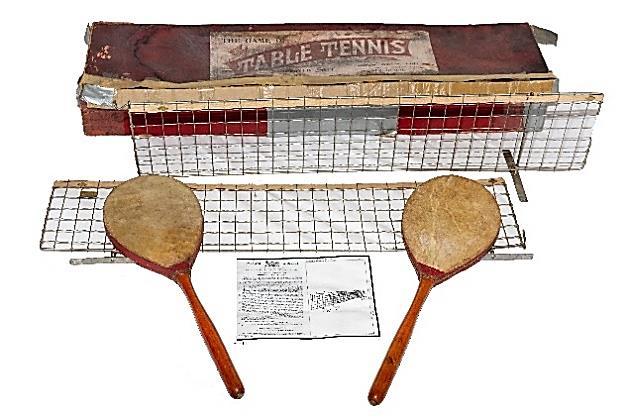
Set sold by Owen & Owen, Liverpool with free-standing metal mesh net patented by Quiggen and Quiggen, also Liverpool, 1902. Photocopy of patent included in foreground
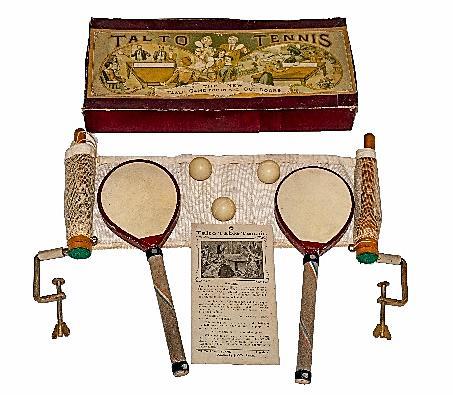
“Talto Tennis” by Faudels. London, the new table game for in and out doors, c. 1902
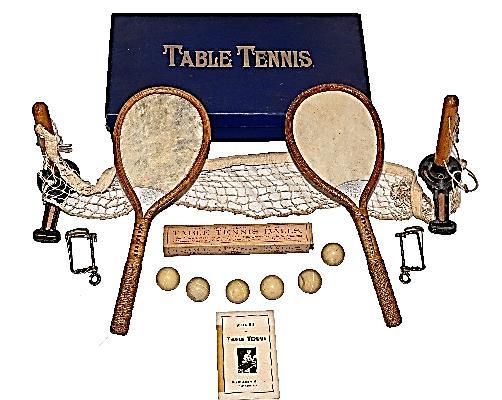
Spalding's Table Tennis set with beautifuly-crafted single-sheet vellum cane battledores and heavy metal bases supporting the posts, c. 1902. This one came via Ebay from the USA and cost me quite a bit more than most of my other sets!

Jaques’ “Gossima or Ping-Pong”, one of three in the collection with the earlier name, c. 1900 with longhandled battledores and tall turned-wood posts that can set the height of the net at either 6, 7 or 8 inches
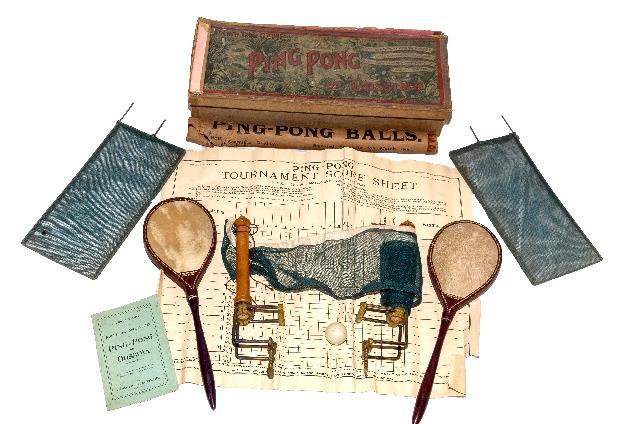
Yet another Jaques’ “Ping-Pong or Gossima” set, c. 1902, but this one includes a scoresheet, a pair of net extenders, a ball tube and a rules booklet - extras not often seen, let alone together!
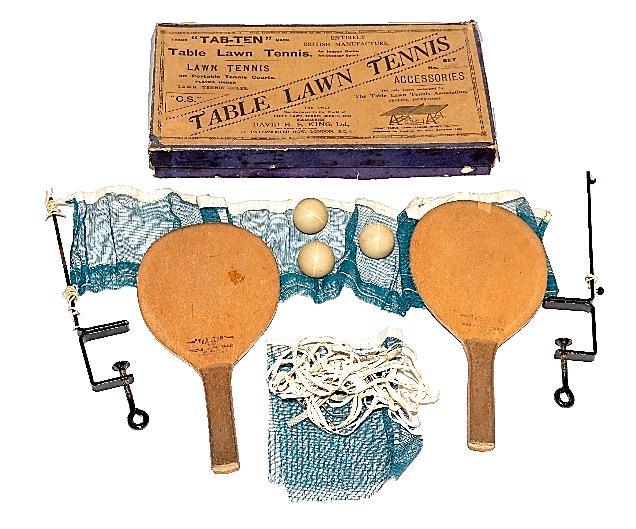
"Table Lawn Tennis" or "Tab-Ten" introduced by David H. E. King in 1922 and short-lived. The associated tables had lawn tennis style markings

A wooden boxed set of “Parlour or Table Tennis” by the Army & Navy Cooperative Society, London, c. 1902. Note the cloth-covered ball, further examples of which are found in a couple of my Ayres’ Cavendish sets

McLoughlin Brothers, New York, Table Tennis set featuring orange-coloured net and free-standing wooden net apparatus, c. 1902
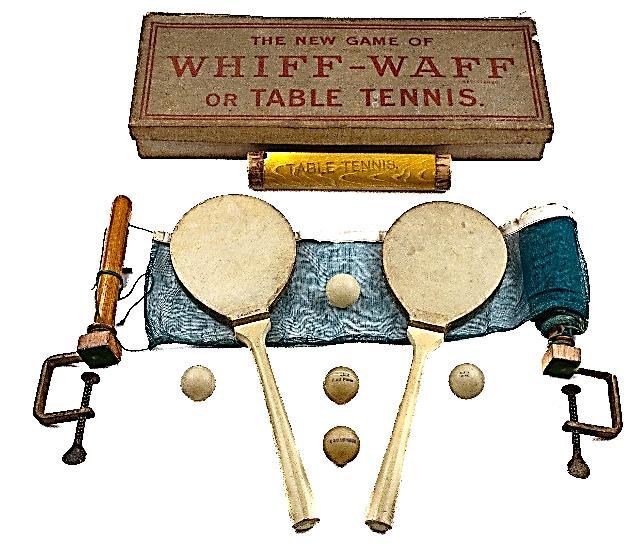
One of four sets of "Whiff-Waff or Table Tennis” by Slazengers in the collection, this being the only one to have a box in remotely good condition, c. 1902. The other three sets feature battledores with unpainted handles
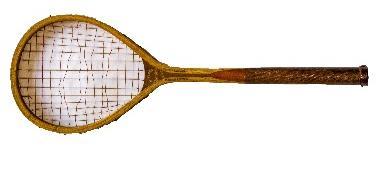
Ayres' gut-strung racket c. 1901 stamped with vendor's name: Mitchell & Co., Manchester

Pair of Gibson Girls pyrographicetched bats, 1900s

An unusually shaped bat, beautifully crafted (home-made?) from a dark wood with initials (possibly LMB) etched into the blade, 1900s

Pair of Jaques’ Ping-Pong bats with polished wood handles and cork-covered blades, 1900s
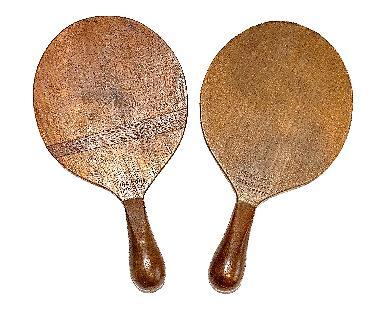
Pair of Hamley's Ping-Pong “GripFat” bats, 1900s
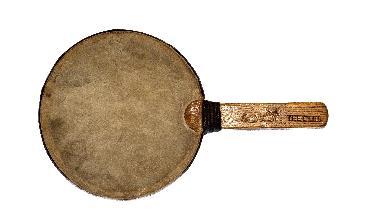
J. R. Malley "The Club" roundheaded battledore, c. 1902
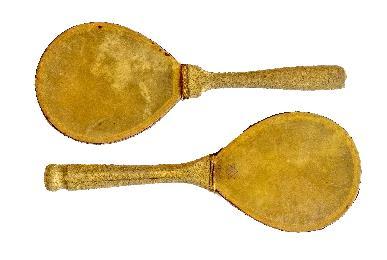
Pair of battledores with suedeleather-bound handles, one with a butt end, c. 1902

Pair of Jaques' “Greenhow” wooden bats, 1900s
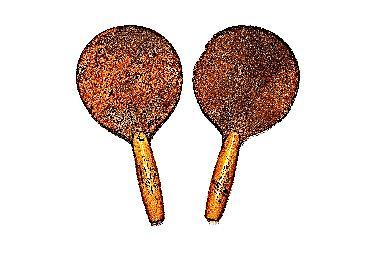
Pair of cork-covered wooden bats with plastic handles embossed with flower designs, 1900s
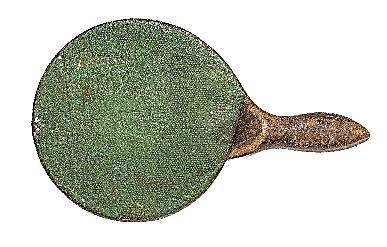
Green pimpled-rubber bat with offset handle similar to that used by Fred Perry to win the 1929 World Championship Men’s Singles, 1930s
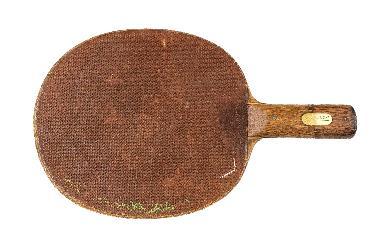
“Barna" pimpled-rubber signature bat with ivorine inset in handle by Walter Briggs, 1930s. Acquired in 2023
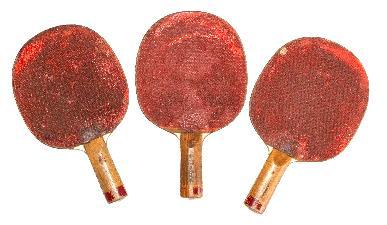
A trio (only two are marked) of "Szabados" signature pimpledrubber bats by Slazengers, 1930s.
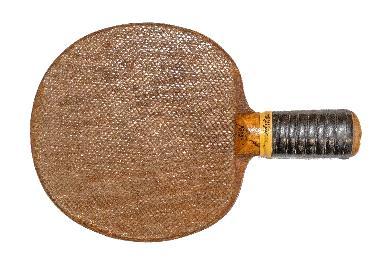
Spalding War-Grade bat covered with webbing rather than rubber, supply of which was scarce, 1940s

Dunlop "Barna" bat with giant pips formed out of the thick sponge layer, 1954. Another 2023 acquisition
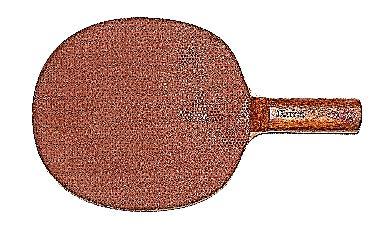
Dunlop "Barna" pimpled-rubber bat with "Dunlop" red tear-drop logo, late 1950s

Issue 51 of Table Tennis Collector, page 10, gave a summary of our colleague Jorge Hernan Arango’s distinguished career as Colombia national champion, national coach, and national administrator. It also showed samples of his huge table tennis collection and promised a museum to come. That was in 2009. The Museo de Tenis de Mesa has long since opened in Medellin.
In this video Jorge gives a tour of his Museo to a group of school children in 2019. https://www.facebook.com/watch/?v=874949426183859

Here is a 2011 slide-show tour...
It was hands-on...

https://tenisdemesanorte.wordpress.com/2011/06/27/museo-jorge-h-arango-y-nacional-demayores/
A 2018 TV feature about Jorge can be seen at https://youtu.be/bSXOqfM1FD0. If you don’t know Spanish, turn on CC and then in Settings choose your preferred language...
“Considered a true example, almost a hero, for the new generations, Jorge Hernán Arango is a paisa who, at 81 years old, still competes in national events. In addition, he was the manager and one of the founders of the National Table Tennis Masters Tournament held annually in Bucaramanga.
“Jorge Hernán Arango was born in Medellín in 1937. In the 1950s he began to take his first steps in table tennis, a sport that gave him the opportunity to be national champion on several occasions. Arango has been one of the main managers of the National Masters Tournament, becoming an example for new generations.

“This civil engineer retains those abilities that led him to be one of the best table tennis players in the country, in a golden era in which this discipline began to make its way in our country...”
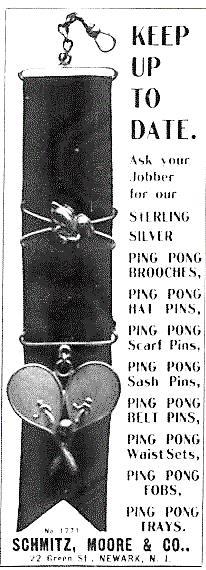
Jewelers Circular, May 28, 1902
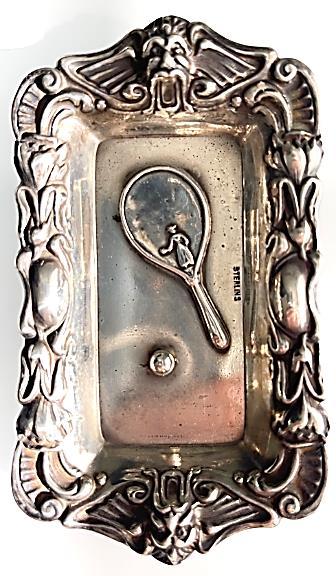
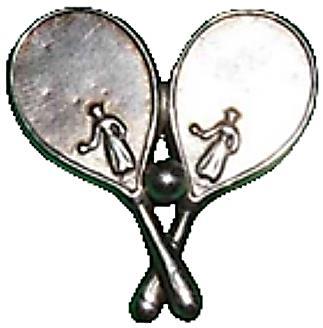

Pin dish and pin tray, bottom, share the double-racket and ball design of the dresser-set jar, here photographed from two angles. Each piece measures two to three inches.

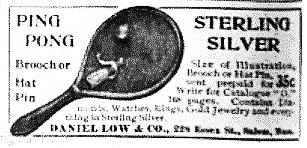
Delineator, October 1902


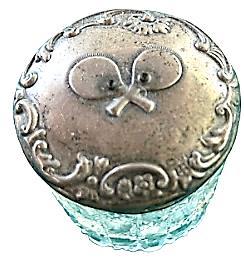
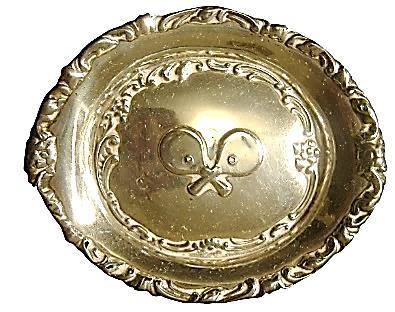
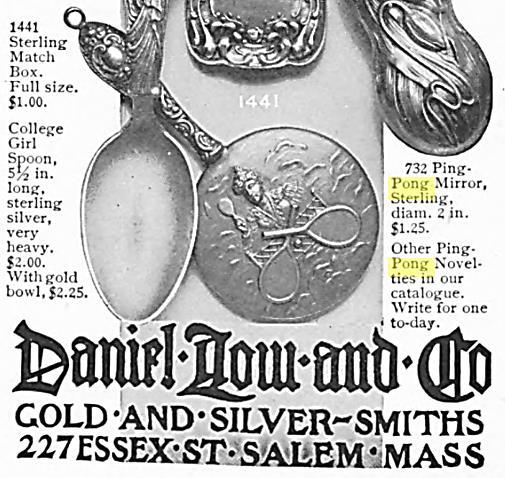
Ladies Home Journal, September 1902
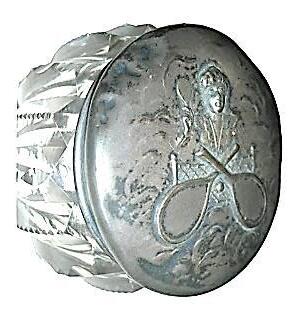


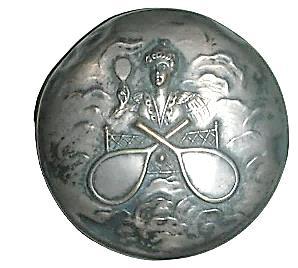
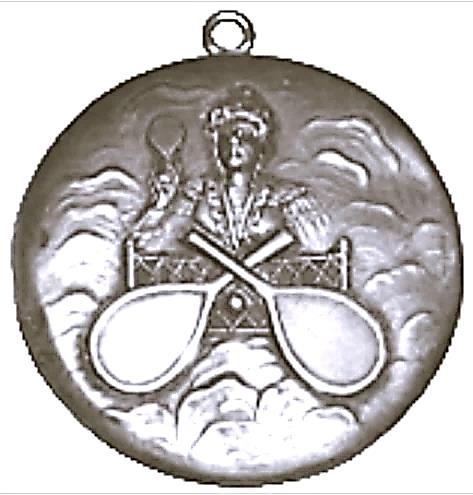
Issues 42, 46 and 100 of TT Collector showed photos of celebrities playing table tennis. You can also see over 1000 such photos at the website of U.S. author/coach Larry Hodges http://www.larrytt.com/celebrities_playing_tt/
Here are a few not shown at those sites, in the actor category, starting with the earliest Backstage Battle Royale at the 1933-34 Broadway drama Mary of Scotland. Queen Elizabeth (Helen Menken) is at left. At right is Mary, Queen of Scots (Helen Hayes) versus Lord Bothwell (Philip Merivale).
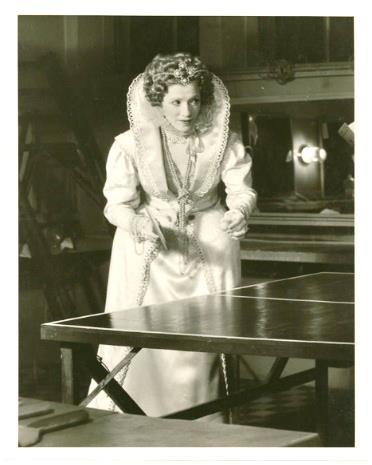
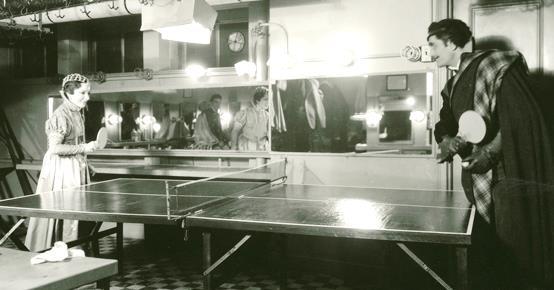
King Kong’s ping ponger Fay Wray, below, gave ping pong parties and was known as a champion in the Hollywood community. But the top champ may have been Ginger Rogers, seen below between Wray and Claudette Colbert at a 1933 tournament.
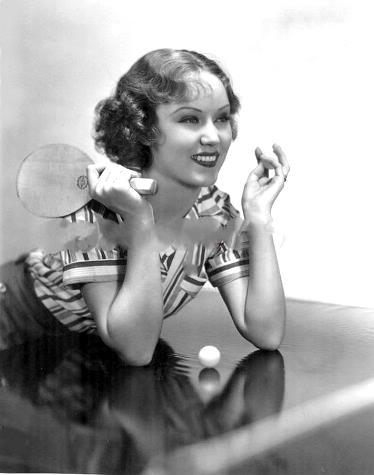


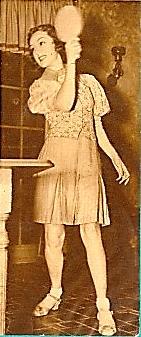
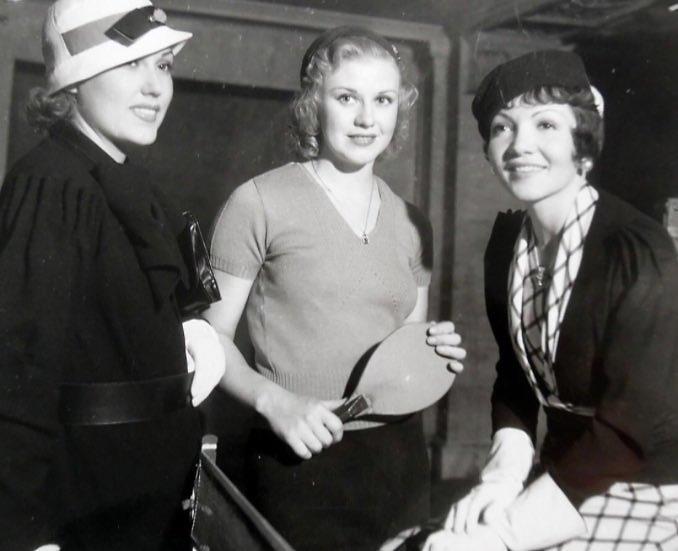
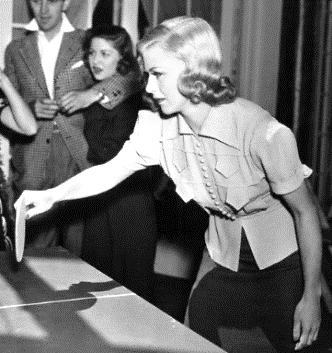

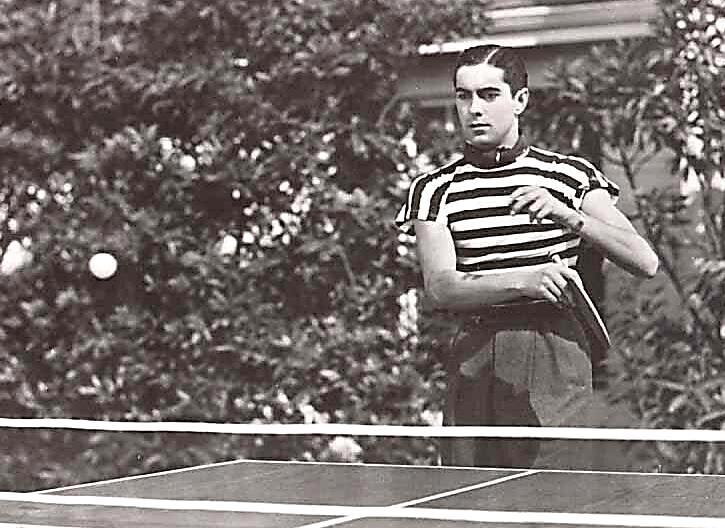

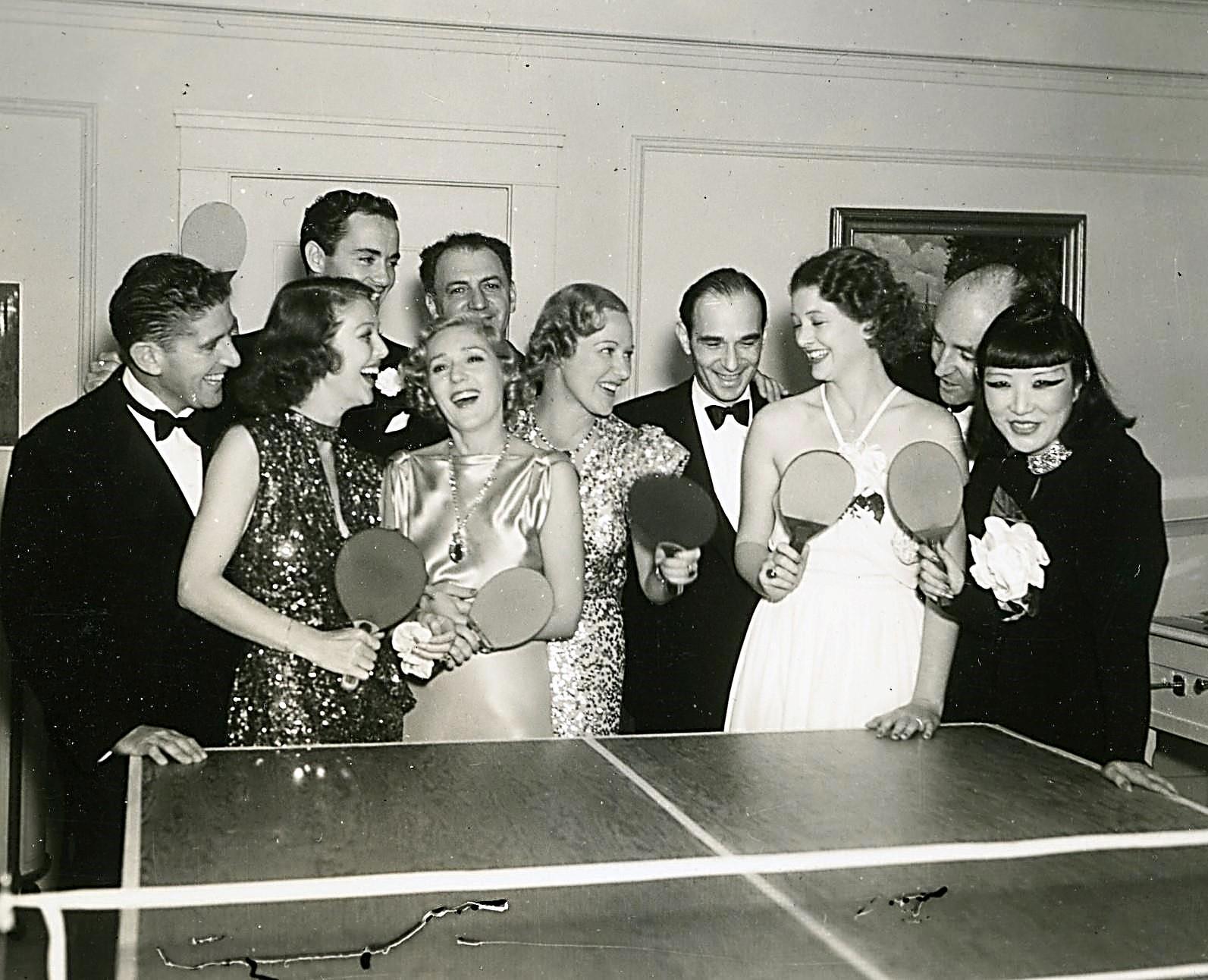

Not in Kansas. Judy Garland must have played a lot, considering her many different table tennis photos. Here are two lesser-known examples, early 1940s. Her doubles partner at left is actor Jackie Cooper.
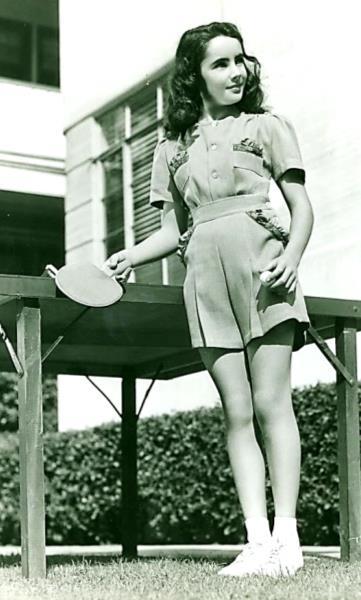
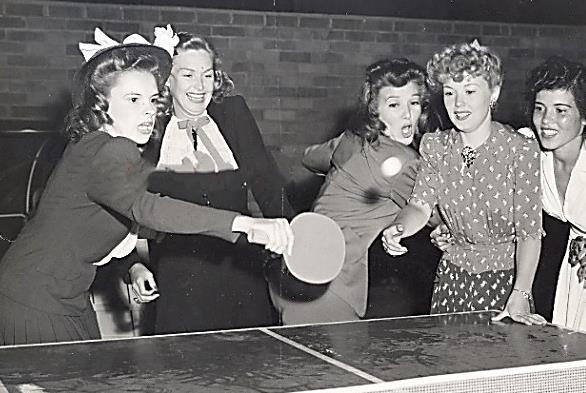
Starting Young. Elizabeth Taylor (left) was only 10 when she made Lassie Come Home (1943). Yet she was already preparing for her table tennis matches against future husband Richard Burton. In March 1970 the couple appeared on the David Frost show, shortly after she won what she called the Ping Pong Diamond. Richard “is really in sort of the professional category,” she said, and he had declared he would buy her a perfect diamond if she could score ten points against him. “I got him sloshed, and I not only got ten points, I beat him.” Richard noted the numerical coincidence of her famous 69.42 carat diamond and the .042 carat Ping Pong Diamond, for which he paid about $14.
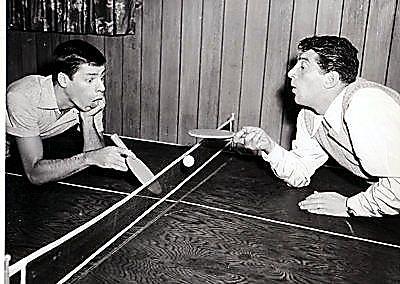

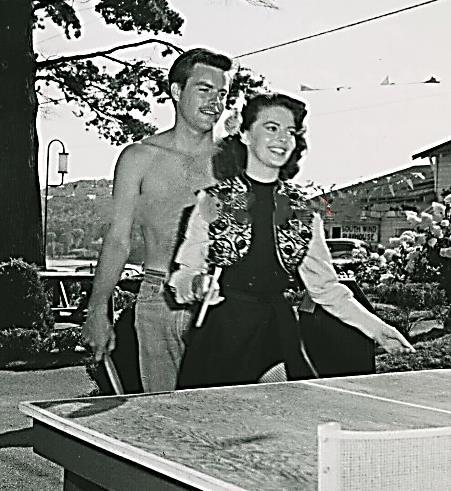
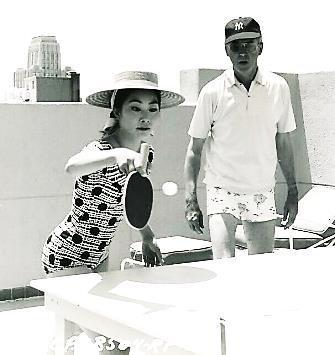
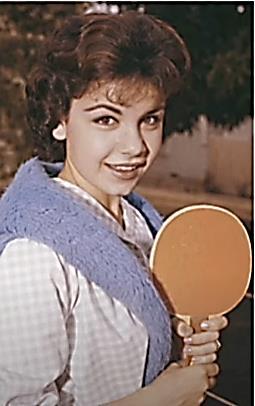


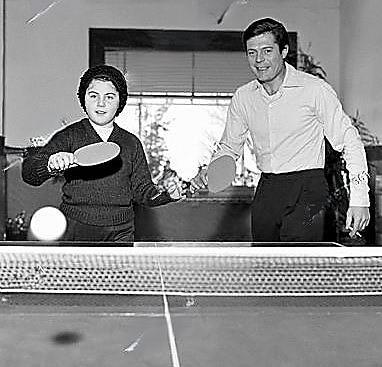
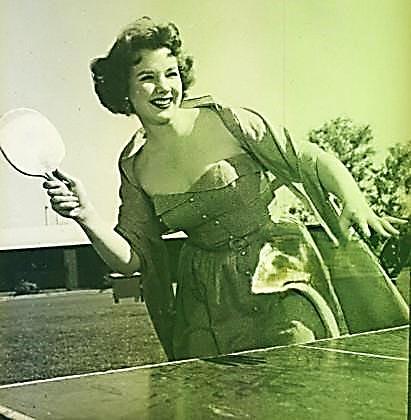
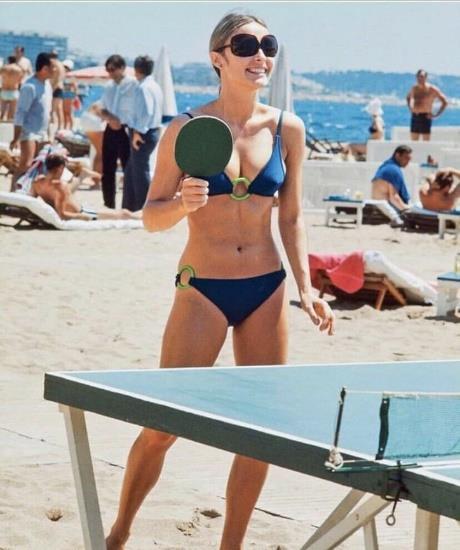
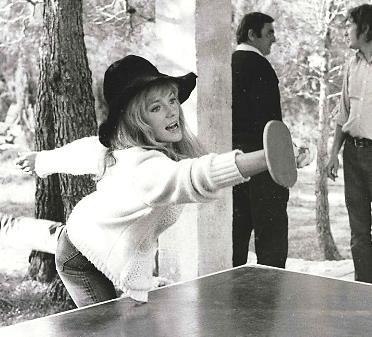
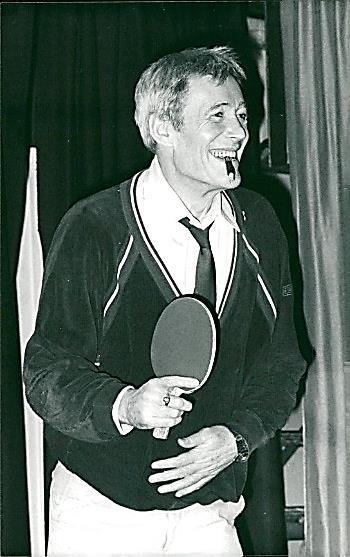
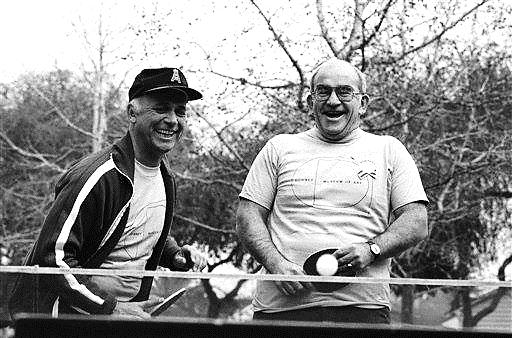
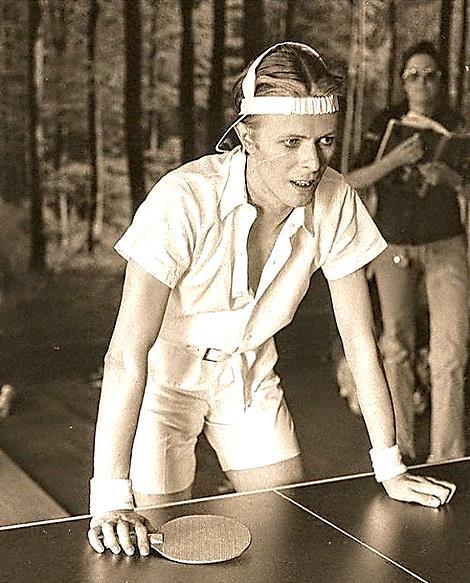
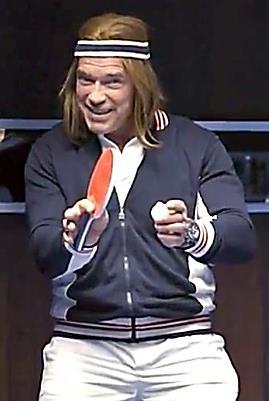
Our colleague Russ Walker (USA) contributes the following for our backcover photo
This interesting tintype photo, measuring only about three inches by two inches, has been listed on eBay since last summer for a lofty $2,495. The U.S. seller says it was found among a group of American photos. Men are holding what appear to be commercially manufactured rackets. They look too thin to be drum battledores (based on the racket at right held sideways), so I suspect they are either wood with vellum and leather trim, or vellum with bamboo frames.
Our Table Tennis History knowledge tells us that this photo likely dates no earlier than 1900. I'm convinced of that. But the seller is convinced it dates to 1890 or older, based mostly on being a tintype. Usually the type of photo is a good dating indication, but in this case it is misleading.


The photo looks staged, like a studio photograph, and the paddles could well be props. Although tintypes were no longer mainstream in 1902, studio photographers did offer them as a novelty well into the early 1900s. If the paddles were custom made that would be one thing, but these clearly are not.
If they are props, which is what I suspect, it makes much more sense that this dates to the Ping Pong craze of the early 1900s. The player at the right holds a ball. If the photo were earlier than 1900, the ball wouldn't be so white. It would likely be a darker cloth-covered, cork, or rubber.
As to clothing, to me they look like they could be 1900 era just as easily as 1890. Derby hats remained popular into the early 1900s. I do agree that tintypes are very rare for Ping Pong, but that doesn't automatically date this to an earlier era. I think our knowledge of the history of the game and type of rackets shown should trump the other evidence.
It is an interesting photo, as I'm sure most collectors will agree, but the asking price seems way out of line. I feel this is another instance where a seller dates something incorrectly and then prices it accordingly. I see that frequently on eBay. As of this writing it was still available at https://www.ebay.com/itm/305018555581